

National Education Policy 2023 – NEP 2023 Highlights
Introduction to national education policy 2023.
The National Education Policy was established in the year 2020. It came into existence during the academic year of 2023-24, thereby becoming popular as the NEP 2023. The policy is termed as one of the pathbreaking and game-changer documents that have been conceived and formulated with the objective of bringing about a complete transformation in the Indian education system by 2030.
The New National Education Policy 2023 critically envisions a brand-new holistic education system for the country, hinging on the effective adoption of modern training methods, application of technology, and imparting practical and contemporary skills, to shape the overall personality of students. The NEP 2023 aims to help students define and recharge their creative, analytical, problem-solving, and critical thinking abilities, topped by actively pursuing digital literacy.
Overall, the NEP 2023 provides for large-scale reforms in higher education, aiming to bring in more flexibility, shifting the focus from exam-centric to holistic and experiential, clearcut provision of entry/exit options, key synchronization of vocational subjects, and portability of academic credits to enable more mobility.
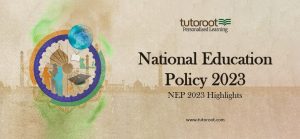
National Education Policy 2023
In summary, NEP 2023 or National Education Policy 2023 outlines the framework for the elementary education system, besides vocational training across the country. The NEP 2023 replaces the National Policy on Education of 1986 and spells out a significant shift in terms of many aspects, affecting certain historical changes. The most important among them is the transition from a 10 + 2 structure to a 5 + 3 + 3 + 4 system.
At the heart of National Education Policy 2023 lies the objective to realize an innovative, student-centric structure that segments student education into four stages: Foundational, Preparatory, Middle, and Secondary. The stages are considered crucial and in a natural order where students progress from one stage to another mentally, shaping and broadening the thought process in a holistic manner.
The NEP 2023 incorporates numerous shifts and changes in the education policy. It also provides for an increase in education expenditure from 3% to 6% of the GDP on a priority basis.
New National Education Policy 2023 Focus
The new education policy focuses on transforming the Indian education system by providing equitable and quality education to all children aged 3-18 years.
NEP 2023 Goals
The goals are to develop creativity, critical thinking, problem-solving, communication skills, and vocational skills, and promote lifelong learning.
New Education Policy 2023 Key Skills
Key skills to focus on include creativity, critical thinking, communication, collaboration, and problem-solving.
Let us list down the key areas where significant changes and shifts have been recommended in National Education Policy 2023:
NEP 2023 – Literacy Goal
To achieve 100% youth and adult literacy by 2030.
Fundamental Structural Change with NEP 2023
National Education Policy 2023 calls for replacing the 10 + 2 structure with a 5+3+3+4 model, recommended to attain foundational literacy and numeracy among students by Grade 3.
NEP 2023 Highlights
The policy states, “The highest priority of the education system will be to achieve universal foundational literacy and numeracy in primary school by 2025. The rest of this Policy will become relevant for our students only if this most basic learning requirement (i.e., reading, writing, and arithmetic at the foundational level) is first achieved. To this end, a National Mission on Foundational Literacy and Numeracy will be set up by the Ministry of Education on priority. Accordingly, all State/UT governments will immediately prepare an implementation plan for attaining universal foundational literacy and numeracy in all primary schools, identifying stage-wise targets and goals to be achieved by 2025, and closely tracking and monitoring the progress of the same”. Subsequently, the NIPUN Bharat Mission (National Initiative for Proficiency in Reading with Understanding and Numeracy) was launched on 5 July 2021 to achieve this goal.
The transition of the model, as per National Education Policy 2023, will be implemented by reclassifying the education stages as the following:
- Foundational Stage: The fundamental stage of laying the foundation that is further stratified into two substages: 3 years of preschool or Anganwadi, followed by classes 1 and 2 in primary school. This essentially covers children between 3 and 8 years. The focus will be on activity-based learning.
- Preparatory Stage: Covering students of class 3-5, and in the age bracket, 8–10 years. Students will be steadily exposed to the fundamental learning aspects of speaking, reading, writing, physical education, art, science, languages, and mathematics.
- Middle Stage: This stage covers students of classes 6 to 8, in the age group of 11 and 13 years. It will introduce students to more abstract concepts in mathematics, sciences, social sciences, arts, and humanities.
- Secondary Stage: Classes 9 to 12, covering the ages of 14–18 years. It is subclassified into two parts: classes 9 and 10, covering the first phase, while classes 11 and 12, covering the second phase. These 4 years of study is intended to inculcate multidisciplinary learning, driven by depth and critical thinking. This provides for multiple options of subjects.
NEP 2023 Examination Structure
The examinations will not be conducted every year but will be held as three milestones, at the end of the classes, 2, 5 & 8.
Revamped examination structure: Students will now actively participate in exams in grades 2, 5, and 8. This reduces the burden and periodicity of assessments that constantly keep children under pressure, with exam-mode preparation overpowering holistic learning. Board exams for grades 10 and 12 will change significantly, where biannual mode will be embraced and objective-descriptive formats will take center stage.
The New Education Policy 2023 thus aims to reduce the curriculum burden on students and will be more ‘inter-disciplinary and multi-lingual’. The reforms begin with the model of examinations.
Mother tongue promotion
The cornerstone of the New Education Policy 2023 is the importance accorded to education in one’s mother tongue. Up to class 5, the medium of instruction will be the mother tongue, with a scope to extend it to grade 8 in the future. In the thick of a national debate where governments are seen fervently promoting English as the medium of instruction from even the primary school level, this prescription reveals the crucial side of education built on the linguistic foundation.
The provision is meant to enhance students’ comprehension and enable the flow of more effective communication with teachers, building stronger bonds, and staying well-connected to one’s cultural roots and background. Through this encouragement, the NEP 2023 intends to enhance language proficiency and clear the cultural chasms encountered by this generation of students.
Interdisciplinary Curriculum
The NEP 2023 encourages interdisciplinary and multilingual education, fostering the promotion of a flexible curriculum that nurtures diverse skills and encourages seamless attainment of knowledge. Transformation is the Mantra that drives the New Education Policy 2023.
Coding and Experimental Learning
Changing according to times, coding will become an integral part of the curriculum in 6th grade, and by integrating experimental learning methods, there will be increased focus on practical and experiential understanding.
Health Focus
The National Education Policy 2023 extends the mid-day meal scheme to include breakfast, with the addition of counselors and social workers to prioritize students’ health and mental well-being.
Higher Education Reforms
Multidisciplinary Bachelor’s Degrees: A flexible 4-year undergraduate program with multiple exit points (certificate, diploma, bachelor’s) that help students gain proficiency in a particular skill set, completely.
- Goodbye to M.Phil.: The New Education Policy 2023 discontinues M.Phil. courses.
- Higher Education Commission: Under NEP 2023, a Higher Education Commission of India will operate to regulate and manage higher education that works proactively on enrollment ratios and ensure higher academic standards.
- Regulatory Councils: As per National Education Policy 2023, a National Higher Education Regulatory Council will oversee higher education (this excludes medical and legal education). Also, a Higher Education Grant Council will financially aid universities and colleges, thus effectively replacing existing bodies.
- Internationalization: The policy fosters international collaboration by allowing foreign universities and institutes to set up campuses and centers in India. This is aimed at maximizing international exposure for students.
- Fee Regulation: Both private and public universities will ensure regulated fees, to realize equitable access to quality education
- College Affiliation: Will be phased out in 15 years, lending autonomous status to the colleges
- District-level Universities: At least one high-quality multidisciplinary institute of excellence will be established in every district of the country by 2030, providing broader access to education
- Multidisciplinary Universities: All universities will graduate into major multidisciplinary institutions by 2040, becoming destinations for holistic education.
NEP 2023 Teachers Policy Alterations
The NEP 2020 has listed certain significant policy alterations with respect to teachers and teacher education. Eligibility criteria have been clearly laid down to become a teacher. This includes a 4-year Bachelor of Education as the minimum requirement needed by 2030. Under the New National Education Policy 2023, the process of recruiting teachers is being strengthened and more transparency and equity is being brought into the system. The onus will be on the National Council for Teacher Education to formulate a National Curriculum Framework for Teacher Education by 2021 and a National Professional Standards for Teachers by 2022.
New National Education Policy 2023 – How is it different from National Education Policy 1986
A significant departure is visible in many areas of the New National Education Policy 2023, in comparison with the older one. Let us broadly analyze some of the key differences between National Education Policy 2023 and National Education Policy 1986:
Holistic approach with a broader focus
In the New National Education Policy 2023, a strong emphasis has been laid on multiple dimensions that positively influence the overall growth of the student, mind development, and career clarity. This is seen in initiatives such as technology usage, experiential mode, and exit and entry options. Whereas, in the older National Education Policy 1986, the focus was on clearing exams, and gaining merits and degrees, since improving national literacy was the major challenge in those days.
Stress on language
The latest NEP 2023 displays unconditional veneration for Indian languages and identifies the cruciality of teaching in the mother tongue. The older policy did not touch down on this. Historic negligence of Indian languages seems to be aptly fixed in National Education Policy 2023, a much-needed attention that was grossly missing in the older education policies.
New Education Structure
With the latest 5 + 3 + 3 + 4 system, the National Education Policy 2023 calls for a paradigm shift that is set to turn into an epochal development. In the older policy, there was little attention or attempt to address the education structure reforms.
Multidisciplinary approach
Choosing a stream of choice with a career and passion in mind is always a challenge for the child. The choking that every child had to go through due to the terms of the older policy has been fixed in the New National Education Policy 2023. NEP 2023 clearly paves the way for a multidisciplinary approach that enables students to opt for subjects across streams, thus encouraging cross-disciplinary learning.
Education from early stages
The National Education Policy 2023 clearly attaches importance to education from early childhood. The older policy did not focus on this aspect.
As the latest NEP 2023 is unveiled and put into action, the world is already witnessing rapid progress and development on the technological front. The advent and intervention of technology have completely changed the way we live. The education sector is not immune to this. The NEP 2023 attempts to raise the bar in this direction and makes ample provisions to encourage and proliferate technological interventions in the education system. In the old policy of 1986, this was obviously missing.
Vocational education
The National Education Policy 2023 invites the incorporation of vocational education in mainstream education with appropriate synchronization that only complements conventional education rather than competing or cannibalizing it. With stress on fostering skill development and boosting entrepreneurship, the NEP 2023 constituents are on the job in the right way. The older policy only resulted in building degree factories where institutions were more into propagating the importance of mainstream subjects with an examination perspective. In the NEP 2023, there is a clear importance given to honing the skills and competencies of the children from a young age, thereby preparing them for their careers.
Experiential Learning
The National Education Policy 2023 is for experiential learning, encouraging learning while observing experiencing, and handling real-world applications. The older policy was hinging on rote learning and memorization.
Changes in Assessment Methods
The National Education Policy 2023 without any ambiguity calls for changes in the way assessment is carried out. This includes the adoption of continuous and complete evaluation, while the older policy of 1986 focused on examinations as the real and final benchmark of a student’s performance. NEP 2023 also proposes setting up of a new National Assessment Centre for evaluating learning outcomes.
Final Notes
This is all about the National Education Policy 2023, hope this article clears all the information about the NEP 2023 along with the difference between NEP 2023 with the previous education policies.
If you are interested in knowing such good information visit Tutoroot the best 1:1 online tuition platform, and click here to book a FREE DEMO from an experienced faculty to experience the new-age teaching methodology.
Related Posts:
- Approved New National Education Policy, What is NEP 5+3+3+4…
- What is 4 Year ITEP Program? - Highlights, Course Details
- Special Debate on Online Education & Advanced…
- Debate on Online Education & Advanced Technologies-…
- Pandemic and it’s Impact on Education
Leave a Reply Cancel reply
Your email address will not be published. Required fields are marked *
Save my name, email, and website in this browser for the next time I comment.
- CSR in Education
- Government Schools
- iDream Education
- iPrep Digital Class
- iPrep Digital Library
- iPrep Tablets
- News Updates
Request a Quote
A closer look at national education policy 2023 (nep 2023), the comprehensive guide to the national education policy 2023 envisioning the transformation of the indian education system, emphasizing critical thinking, fostering holistic development, and embracing global perspectives..
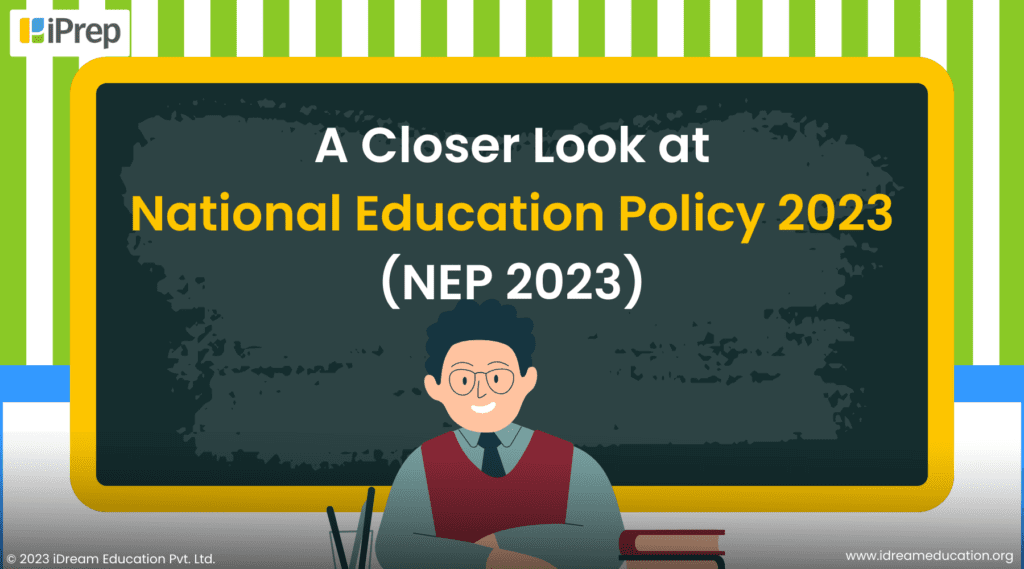
The National Education Policy (NEP) 2020, since its release, has led to transformative changes in the Indian education ecosystem. Its far-reaching impact can be seen through a multitude of changes it has initiated, such as the shift towards curriculum-aligned learning, regional languages being the medium of instruction, integration of technology in education, promotion of vocational and skill-based learning, and bridging the gap between academic and practical knowledge. The NEP 2020 has undoubtedly set the stage for a brighter and more inclusive future for education in the country.
Innovative Shift in National Education Policy 2023 (NEP-2023)
Under the visionary leadership of prime minister shri narendra modi ji and the ministry of human resource development, the new education policy of 2023 ( nep 2023 ) marks a pivotal milestone in the nation’s educational journey. the policy was released on 29 july 2020 after approval by the union cabinet..
In response to the evolving demands of the contemporary era, this policy underscores the importance of comprehensive education focusing on digital literacy, skill development, and holistic learning.
The main purpose behind redefining NEP policy is:
“To universalize education and make India a global knowledge superpower”
Effects of Redefining NEP 2023
- NEP 2023 promotes skill-based education, fostering critical thinking and problem-solving.
- Inclusivity is a key focus, offering equal opportunities for diverse learners.
- Emphasis on local languages and cultures provides a global perspective.
- Improved teacher training and increased funding for better infrastructure.
- Embracing digital education to prepare students for a tech-driven future.
- NEP 2023 paves the way for holistic and meaningful learning.
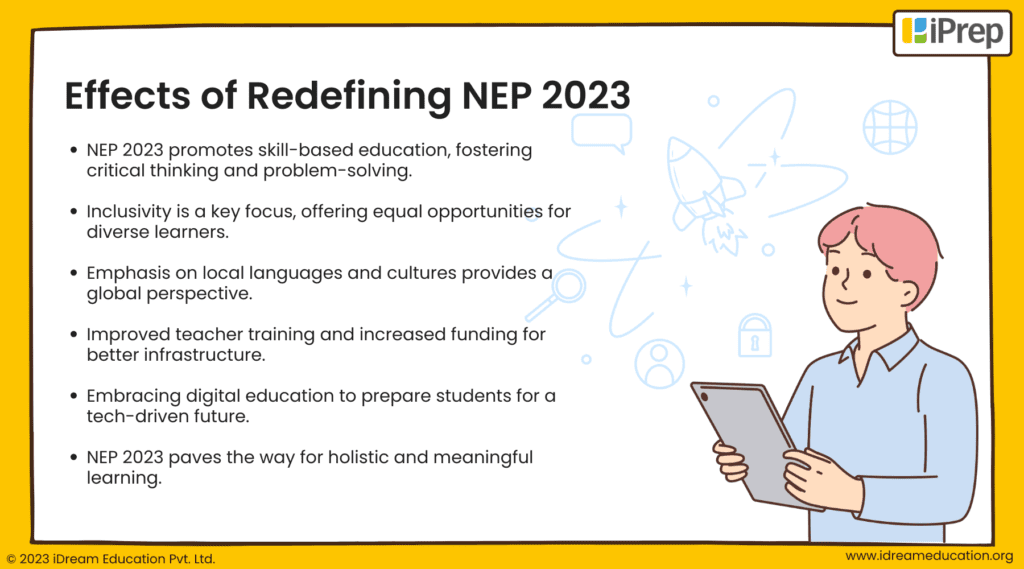
A significant change in NEP 2023 from the past involves:
The transition from the conventional 10+2 model to the ever-growing 5+3+3+4 structure. This framework places a strong emphasis on fundamental skills and life competencies at every educational level.
What does 5+3+3+4 Structure mean?
NEP 2023 redefined the educational framework to a 5+3+3+4 structure to enhance and align the traditional learning system with the evolving needs of students.
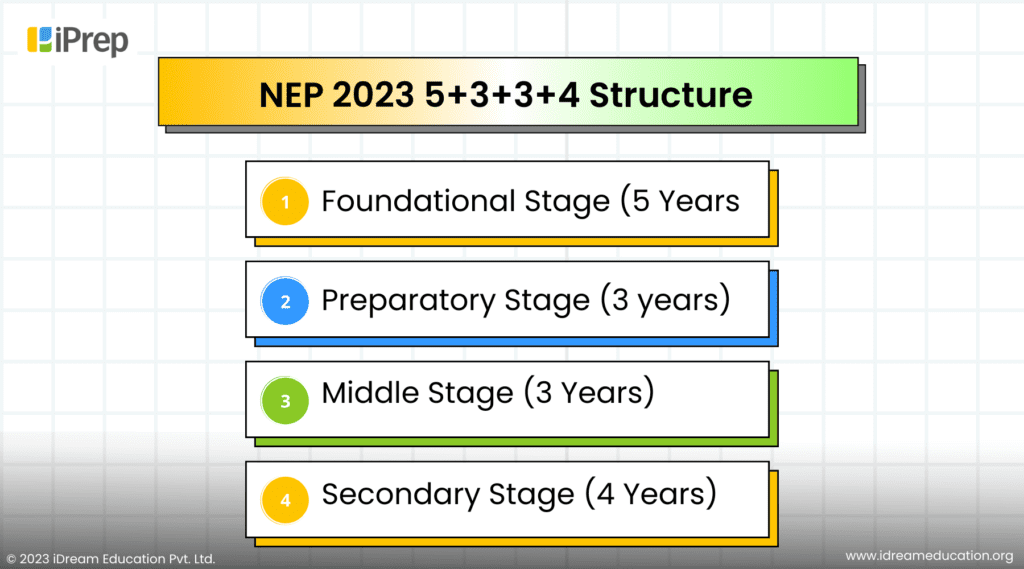
To create a holistic pedagogical environment, National Education Policy 2023 emphasizes on:
Foundational stage (5 years).
During the first three years of pre-primary education, children will primarily engage in playful and interactive learning activities, while the following two years in classes 1st and 2nd the focus will be on the development of Foundational Literacy and Numeracy ( FLN ) skills.
Preparatory Stage (3 years)
During this three-year phase, the primary emphasis is on students of classes 3rd, 4th, and 5th grades where a multifaceted teaching approach will be integrated as it seamlessly integrates various subjects, providing a well-rounded and holistic learning experience. The focus of preparatory stage centers on fostering a sense of discovery and exploration, aiming to steer away from rote learning of complex concepts. It is important because at this stage when the curriculum gets deep it becomes necessary to encourage a deeper understanding and the practical application of knowledge.
Middle Stage (3 Years)
During this three-year phase, the emphasis is on delving deeper into the subject matter for students in 6th, 7th, and 8th grades. The Middle Stage will focus on helping students explore subjects in greater detail, thereby enabling critical thinking. Furthermore, the Middle Stage is dedicated to introducing project-based learning to help students gain hands-on experience.
Secondary Stage (4 Years)
In the final four years of school, from grades 9 to 12, students get ready for their future. Some for higher education or vocational paths. Therefore, during this stage, when students can choose what they want to study, the focus will be on holistic development. This will help them gain real-world skills and competencies.
Guidelines of NEP 2023
- Holistic Development Focus: NEP 2023 fosters cognitive, emotional, and societal growth for students.
- Early Foundational Learning: Prioritizes Early Childhood Education and Care for strong foundations.
- New Curriculum Structure: Introduces a 5+3+3+4 structure for experiential and skill-based learning.
- Vocational Education Goal: Aim for 50% of learners in vocational education by 2025 is to contribute to the Nation’s human capital.
- Regional Language Learning: Emphasizes regional language learning up to Grade 5, to enable a familiar learning environment.
- Tech-Driven Education: NEP 2023 emphasizes using platforms like DIKSHA to enable access to quality education.
- Adaptive evaluation system: The policy emphasizes rethinking assessments to shift from summative to a more comprehensive evaluation system.
- Teacher Training: Continuous training and professional development of teachers to align with evolving teaching approaches.
- Inclusivity and Equity: NEP 2023 commits to ensuring education for all, regardless of socioeconomic or physical barriers to learning.
It’s truly inspiring to witness the proactive approach of the Government of India in revamping the National Education Policy (NEP).
In line with NEP 2023, iDream Education is happy to underscore its alignment with the policy’s vision, as it centers on fostering the holistic development of students through its comprehensive, one-stop learning platform, iPrep . This platform places equal emphasis on both academic and non-academic growth.
iPrep’s alignment with 5+3+3+4 Structure
In harmony with the new Curriculum 5+3+3+4 framework, iPrep offers a diverse range of curriculum-aligned multi-category content for students in grades K-12, available in Hindi, English, and seven other regional languages. Beyond academics, iPrep delves into areas such as life skills, value education, vocational content, climate change awareness, activity and project-based learning, and more for the holistic growth of students. Furthermore, iPrep prioritizes experiential and skill-based learning for different grades. It’s meticulously designed to draw content from Open Educational Resources (OER) sources/platforms such as DIKSHA and Khan Academy, thereby ensuring access to quality education.
iPrep PAL, a personalized adaptive learning solution by iDream Education enables an adaptive evaluation system
iPrep PAL is a structured app featuring an adaptive evaluation system that shifts the focus from summative assessments to a more comprehensive evaluation approach. This personalized adaptive learning solution tailors individual learning paths for each student, recognizing their unique learning needs and abilities.
What else is in line with the NEP 2023?
We not just focus on developing and delivering our solution but our commitment lies in the successful implementation of the solution, with comprehensive and ongoing teacher training programs, ensuring teachers can effectively digital in their daily classroom sessions.
Lastly, with a focus on local language medium, a multi-category curriculum alignment, ICT labs, and offline digital learning content, iPrep stands as an inclusive and equitable solution that caters to all learners. With its adaptability to various devices and operating systems, it eliminates socioeconomic and physical barriers to learning.
To Conclude
This revamping of NEP at this juncture has the potential to transform the Indian education system into a more inclusive, flexible, and learner-centric one. iDream Education looks forward to working with System Integrators, Government entities, corporations, foundations, NGOs, and other ecosystem partners to facilitate a holistic and integrated education approach.
Frequently Asked Questions -
1. what is national education policy 2020.
The National Education Policy, 2020 (NEP) aspires to bring about a substantial transformation in education by establishing a system deeply rooted in Indian values. This system aims to play a direct role in the sustainable transformation of India, also known as Bharat, into an equitable and vibrant knowledge society.
2. What does the revision aim to achieve within NEP 2020?
The revision in NEP 2020 to NEP 2023 is to universalize education and make India a global knowledge superpower.
3. What is the new proposed education structure in NEP?
The NEP 2023 brings flexibility to primary and secondary education, shifting from the rigid 10+2 system to a more adaptable 5+3+3+4 structure. The four stages are defined as foundational, preparatory, middle, and secondary stages. This framework places a strong emphasis on fundamental skills and life competencies at every educational level.
4. How can technology support the goals outlined in India's National Education Policy (NEP)?
India's National Education Policy (NEP) emphasizes on integration of technology in schools. Technological integration could be smart devices such as educational tablets, mobile apps, smart ICT Labs, Personalized Adaptive Learning (PAL) solutions, or learning platforms.

Ayushi Agarwal
Ayushi Agarwal is an Assistant Manager - Marketing & Content Writing at iDream Education. With 7+ years of writing, her focus has shifted passionately to education over the past two years. Her dedication lies in researching and crafting content around solutions that address learning gaps, drive sustainable digital learning programs, empower last-mile learners, and ensure educational access for all. This commitment makes her work a valuable asset for social sector leaders seeking to drive change.
[email protected]
Share this post
Related articles.

Celebrate Independence Day with the Har Ghar Tiranga Initiative: Ignite a Deep Sense of Patriotism
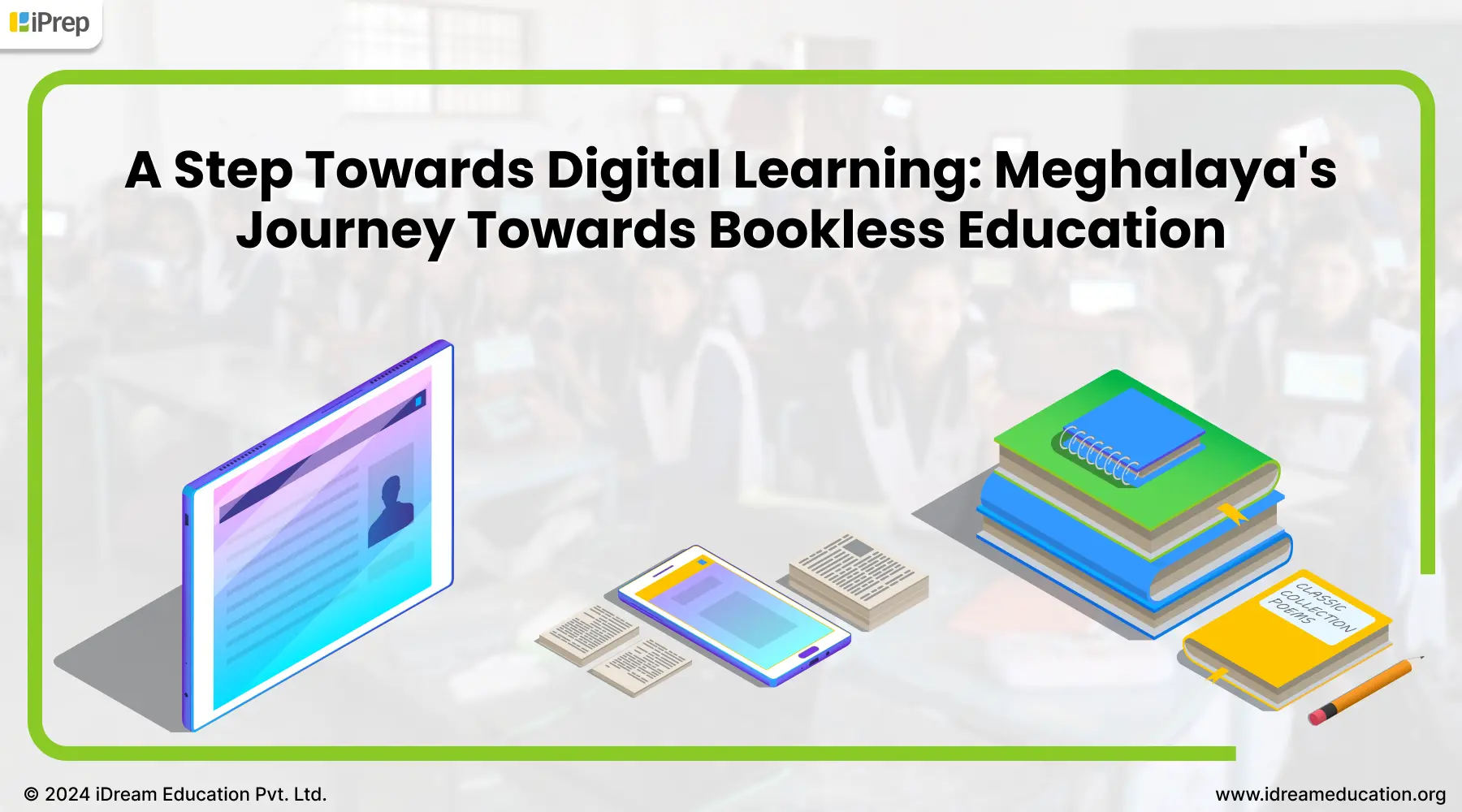
A Step Towards Digital Learning: Meghalaya’s Journey Towards Bookless Education

Bridging the Language Gap: iPrep, A K-12 Learning Platform with Digital NCERT Books in Hindi
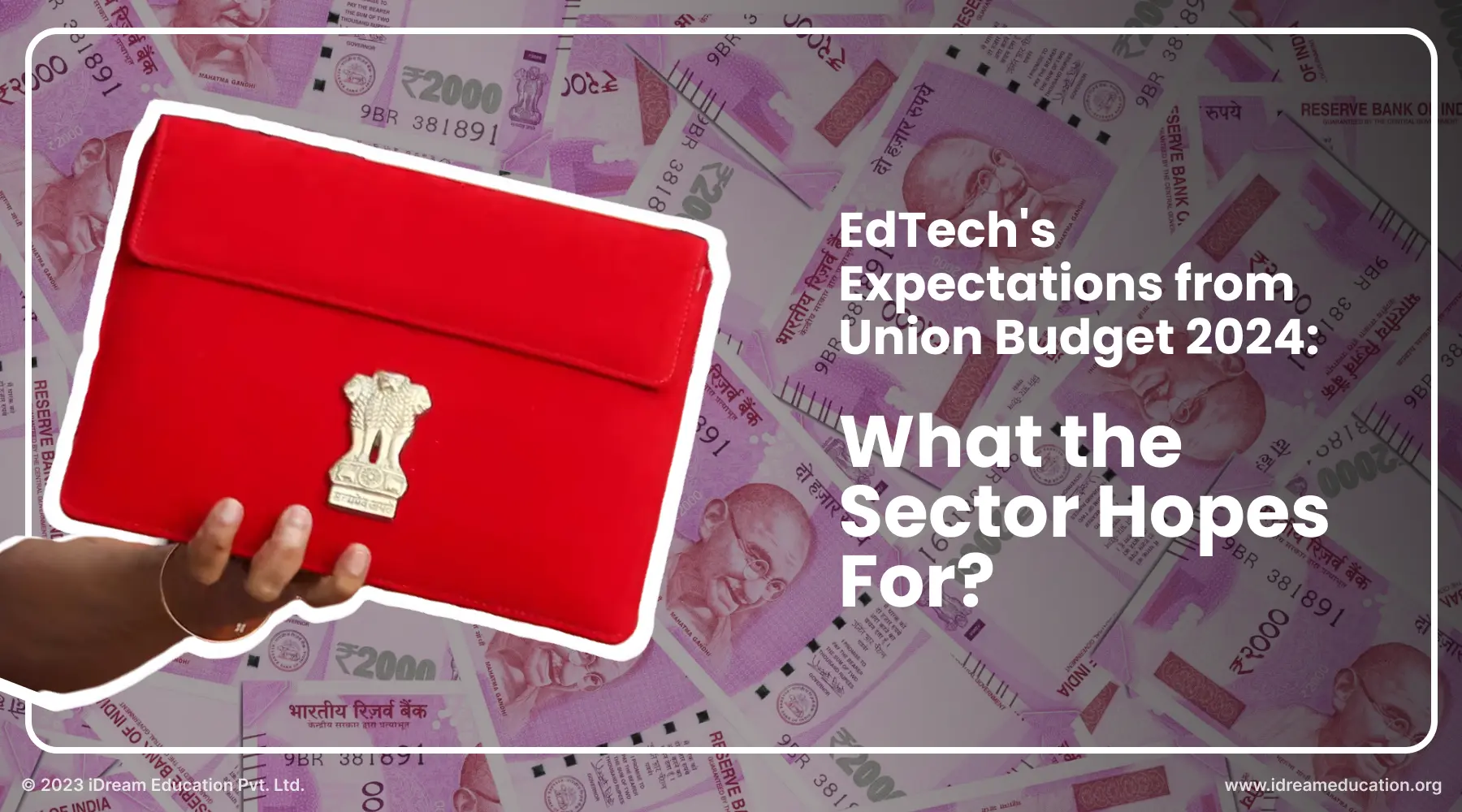
EdTech’s Expectations from Union Budget 2024: What the Sector Hopes For?

A Comprehensive Guide to MP Board Content on iPrep
Leave a reply cancel reply.
Your email address will not be published. Required fields are marked *
Academia.edu no longer supports Internet Explorer.
To browse Academia.edu and the wider internet faster and more securely, please take a few seconds to upgrade your browser .
Enter the email address you signed up with and we'll email you a reset link.
- We're Hiring!
- Help Center

NEP-2020.pptx

2020, NEP-2020
This is based on National Education Policy 2020 in India, launched after 34 years. This is an attempt to highlight the salient and core features of the Policy.
Related Papers
Zenodo (CERN European Organization for Nuclear Research)
Dr. Tejpal Moharekar
India’s National Education Policy 2020: Critical Analysis
Prof.Sudhir Gavhane
Government of India in view of transformations happening in the world & education sector has came out with “National Education Policy 2020 “ , popularly known as NEP 2020, with aim of transforming education sector , in alliance with global trends and technologies, promoting multidisciplinary research , quality and achieving 50 % GER , investment 6 % of GDP for education sector , steadily do away with affiliating system of colleges, providing autonomy to HEIs to become globally competitive in Global Knowledge Economy based on innovation & research . This edited book examines critically the possibilities of implementation of NEP2020 and problems in execution. This an excellent policy document but with difficulties in implementation & execution. It needs Polital will , prioritisation of education, quality enhancement, filling up thousands vacant position of teaching and research faculties, lack of academic and research culture and providing huge required resources to universities. #NEP2020 #KnowledgeSociety#Research&Development #India #university # Research&Innovation #KnowledgeEconomy #HigherEducationInIndia
BOOK CHAPTER IN A BOOK : EMERGING TRENDS IN EDUCATION, MANAGEMENT AND SOCIETY , PUBLISHED BY ASIAN PRESS BOOKS KOLKATA
Pankaj Thakur
The education system relies on the policies drafted by the govt. To strengthen the base of curricula and to develop a scientific temper, the Indian govt. has drafted policies from time to time. Before NEP 2020, the Indian govt. has drafted two national education policies. This is the third education policy that came after a long period. Early childhood education has been integrated into regular school for the first time under the new policy. With increased use and deployment of current technologies, skill-based learning is being prioritized. From a global perspective, the NEP 2020 aims to bring much-needed revolutionary changes to the Indian education sector. The NEP, 2020 envisions the holistic development of the education system.
isara solutions
International Research Journal Commerce arts science
The National Education Policy 2020 is a welcome and ambitious re-imagination of India's education system into a modern, progressive and equitable one. National Education Policy (NEP), established in 2020, came into effect during the 2023-2024 academic Yearbringing with it a slew of changes. NEP 2020 especially focuses on Access, Equity, Quality, Affordability, and Accountability. Therefore, National Education Policy-2020 has assured a remarkable step for quality and accountable education. But there are many hurdles to face before we can successfully implement such a transformative policy. The article is going to highlight and discuss such challenges.
Mukul Mahato
IOSR Journals
The National Education Policy 2020 (NEP) has come after thirty-four long awaited years and there is much hope that this policy will propel the Indian education sector into the 21 st century of modern learning. While the NEP 2020 addresses most of the key issues faced by the Indian education system, there are some points that need closer scrutiny. This paper focuses on explaining the key objectives and features of NEP 2020 and then assesses the advantages and disadvantages of the policy. Furthermore, the paper concludes by mentioning some aspects that need to be considered in the way towards transformation of the Indian education sector.
The Spicerian
ashwini mahamuni
International Res Jour Managt Socio Human
National Education Policy 2020, announced by the Government of India on July 29, 2020, revolves around the flexible, practical, multidisciplinary, multilinguistic education for all, at all levels, by implementing many reforms, interventions and a nationwide institutional set up. This study aims to review different aspects of the policy in comprehensive manner and analyse its impact. It's designed as descriptive study of the policy based on qualitative analysis of the secondary data. The study finds that NEP is a long tenure policy that has the potential to impact every individual and household's life. If implemented rightly, it will change the status of India in global competitiveness and capability building. The study will be particularly helpful to the students, researchers, academicians and professionals seeking an analytical comprehensive summary of the National Education Policy 2020.
IJARW Research Publication
National Education Policy-2020 (NEP) is drafted with a long-term vision of making India. This policy is a landmark document that aims to transform the Indian education system at all levels. The policy has a number of ambitious goals for higher education. NEP-2020 approved by Indian Union Cabinet on July 29, 2020 which is set out the vision for new education system of each Indian. This policy is related to increasing access, improving quality and promoting the different area of research and innovation factor. The aim of policy is to function able or applicable by 2021. It clearly mention that no one force to learn at any level. This policy has been approved after a long brainstorming session. It is based on the pillars of Access, Equity, Quality, Affordability and Accountability. The Policy also aims to improve the quality of teacher education, increase the use of online and blended learning and create a more student-centric and flexible education.
Gavisiddappa R Angadi
India today has around 1,000 universities across the country. Doubling the Gross En- rolment Ratio in higher education by 2035 which is one of the stated goals of the poli- cy will mean that we must open one new university every week, for the next 15 years. Opening one University every week on an ongoing basis is an undoubtedly massive challenge.
Loading Preview
Sorry, preview is currently unavailable. You can download the paper by clicking the button above.
RELATED PAPERS
Dr.Tapas Barman, Ph.D
Dr.Ashutosh Gaur
Social Change 50(4)
Govinda Rangachar
International Journal For Multidisciplinary Research
ANANYA NANDI
Deepika Mondal
International Journal of Culture and Modernity
University News
Dr Arvind M Nawale
International Journal of Management, Technology, and Social Sciences (IJMTS)
Srinivas Publication , Sreeramana Aithal
Indranil Bandyopadhyay
Jai Maa Saraswati Gyandayni
DR. DHARMENDRA K U M A R SINGH
Research Scholar
Abnish Singh Chauhan
International Journal of Social Science and Education Research
International Journal for Research in Applied Science & Engineering Technology (IJRASET)
HAREKRUSHNA BEHERA
International Journal of Human Development and Information System
Dr. Shireen N Fatma
Harshwardhan Publication
Dr. Saba Inamdar
Social Change
Poonam Batra
Higher Education Research
adhikarla rao
Shaurya Thakur
ijetrm journal
Ijetrm Journal
Red Publication
SANTU BISWAS
Education and Society
Tushar Rupanavar
- We're Hiring!
- Help Center
- Find new research papers in:
- Health Sciences
- Earth Sciences
- Cognitive Science
- Mathematics
- Computer Science
- Academia ©2024
What Brown Center scholars will be watching in education policy and politics in 2023
Subscribe to the brown center on education policy newsletter, daphna bassok , daphna bassok nonresident senior fellow - governance studies , brown center on education policy michael hansen , michael hansen senior fellow - brown center on education policy , the herman and george r. brown chair - governance studies douglas n. harris , douglas n. harris nonresident senior fellow - governance studies , brown center on education policy , professor and chair, department of economics - tulane university katharine meyer , katharine meyer fellow - governance studies , brown center on education policy rachel m. perera , rachel m. perera fellow - governance studies , brown center on education policy jon valant , and jon valant director - brown center on education policy , senior fellow - governance studies kenneth k. wong kenneth k. wong nonresident senior fellow - governance studies , brown center on education policy.
January 10, 2023
From the continued response to pandemic disruptions to culture war issues that have surfaced in schools, 2022 was an eventful year for U.S. schools and education policy. That looks to be true for 2023 as well.
Below, experts from the Brown Center on Education Policy identify the education stories that they’ll be following in 2023, providing analysis on how these issues could shape the learning landscape for the next 12 months—and possibly well into the future.

In 2023, I’ll be watching innovative state and local efforts to better fund childcare and better support early educators. The pandemic highlighted the essential role childcare plays in the lives of children, families, and the U.S. economy. It also made clear that without greater public support, childcare providers cannot pay teachers adequately and cannot offer families essential supports. The high teacher turnover rates common in early childhood settings compromise quality, and during the pandemic, they also compromised access to care. In Virginia, two thirds of publicly funded childcare centers shut down classrooms or turned families away because they could not recruit and retain teachers.
Pandemic relief dollars provided an essential lifeline to childcare. However, as these funds run out, states are now facing a stark funding cliff which will exacerbate staffing challenges considerably. New Mexico recently passed a ballot measure to establish a permanent funding source in the state constitution, making it the first state in the country to do so . Washington, D.C. approved funding to work towards childcare compensation that approaches the pay of other D.C. teachers. Virginia recently changed their approach to funding subsidized childcare to better account for the true cost of childcare, including better compensation. I’m hopeful other states will follow with big investments and that as the federal funding cliff approaches, we’ll finally see large federal investments in childcare.
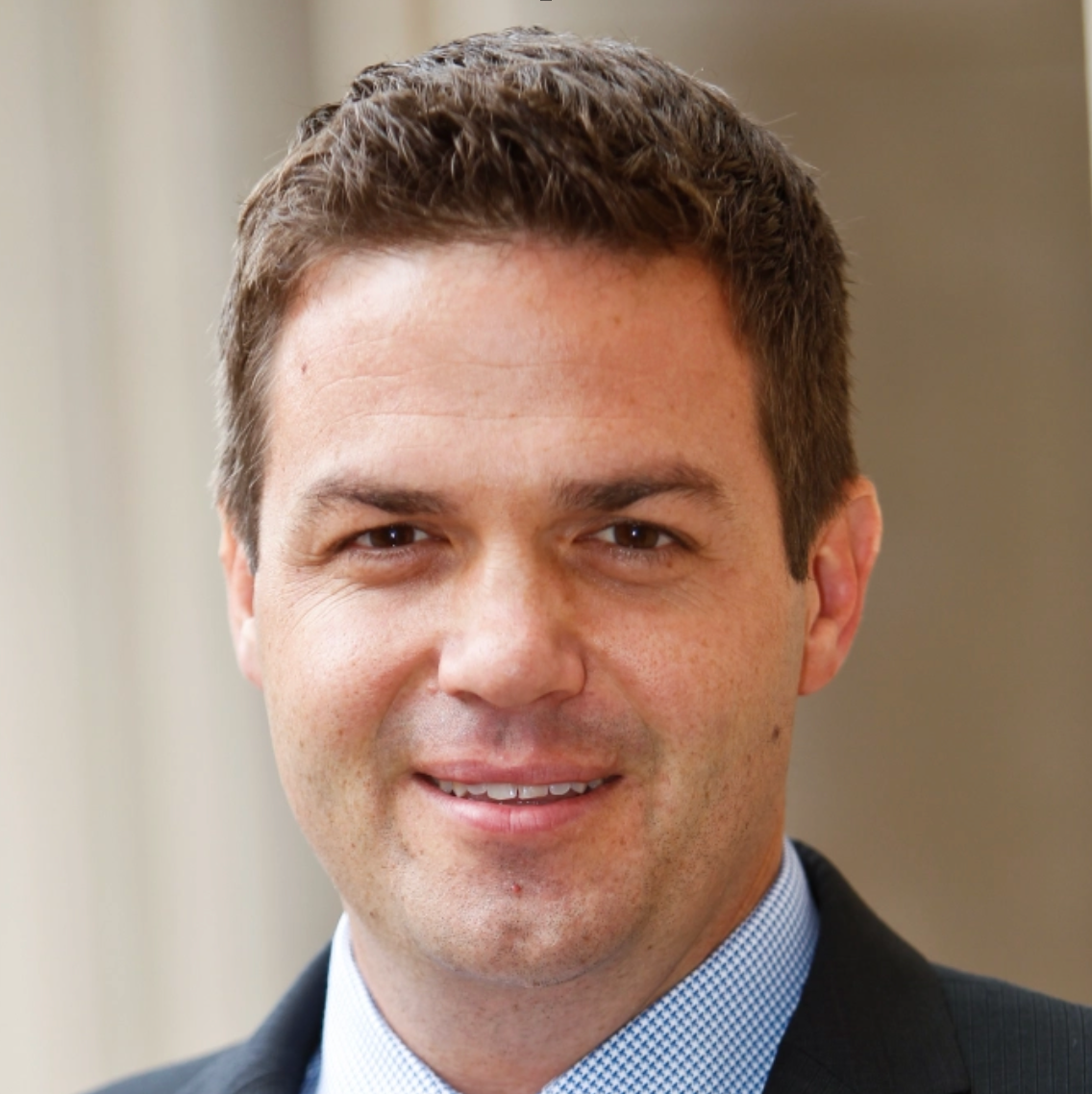
Heading into 2023, I am monitoring the status of the K-12 teacher workforce and reports of teacher shortages. The COVID-19 pandemic has stretched many schools’ human resources in recent years, with teachers reporting heightened burnout and intentions to leave . Combined with preexisting trends of a weakening teacher pipeline and anemic application pools for certain positions and settings , many worried that we may tip into a full-scale crisis.
I am pleased to report that recent evidence increasingly points in the direction of the teacher workforce weathering the storm, even if the rains haven’t yet fully subsided. For example, district surveys from the spring of 2022 pointed to expected turnover in the current school year (2022-2023) likely being slightly less taxing than last year (2021-2022). New evidence from Washington State shows even the elevated turnover experienced in 2021-2022 was within the range of historical teacher turnover spanning nearly four decades. Finally, another new study from Illinois points to increased staffing levels, particularly among non-teacher staff, as the primary driver of elevated vacancies in schools, even as student enrollments are falling. These reports and other data points give me confidence that we’ll make it through.
Don’t celebrate just yet, though. We still have work to do shoring up localized shortages in spots that have persistent hiring problems and doing what we can to make the teaching profession more attractive , especially among people of color .

The first thing I’m looking for in 2023 is a sign that educators, families, and students have responded to COVID-19 by making permanent and systemic improvements in schooling. As I’ve written before , COVID-19 forced everyone into novel practices. Did they develop new habits that are having lasting positive influence, such as using new kinds of devices and software? Or did remote learning create bad habits (e.g., distraction from smart phones) that are making it even more difficult for students to rebound? Anecdotally, I think the answer is “both,” but I hope some enterprising researchers and journalists are looking into this.
There’s also something I’m not looking for: I don’t expect a noticeable student rebound from COVID-19 learning loss anytime soon. The early evidence doesn’t provide much reason for hope. I think this is because: (a) if educators knew how to get students to catch up from a massive upheaval like this, they would have already been doing this for struggling students before COVID-19; (b) hiring more educators or bringing in new programs with the ESSER funds has proven difficult because of the tight labor market and temporary nature of the funds; and (c) the take-up rate on voluntary, after-school learning activities has been low .
I’m not exactly optimistic that we’ll “solve” this quickly, but hopefully there’s at least a silver lining in the form of better teaching that will help address the problem gradually, over the long run.

In 2023, my eyes are on the Supreme Court for two consequential higher education decisions. First will be an expedited hearing on the Biden administration’s proposed student loan forgiveness program. The administration accepted 26 million applications for debt relief this fall; however, forgiveness is on hold until the Supreme Court hears oral arguments in February about the legality of the program. For now, the administration has extended the pause on loan repayment. But regardless of the Court’s ruling, restarting payments on remaining balances after a three-year pause will be a significant shift in individuals’ budgets. It is incumbent on the Department of Education to provide borrowers with clear, advance communication about repayment options and resources to avoid default.
Second, the Court heard arguments in October 2022 about the consideration of race in college admissions in two separate cases. I anticipate the Court will rule in favor of the plaintiff in both cases, effectively ending the use of affirmative action. This raises the question of how colleges will shift their recruitment and admissions processes to advance their goals of a diverse community of scholars. Colleges will need to examine what other admissions practices, such as legacy admissions or the review of test scores, they may need to adjust to achieve their mission.

In 2023, I will be following two issues in K-12 education policy that have important implications for equity.
First, the Biden administration has signaled that new guidance on how public schools can avoid racial discrimination in school discipline may be forthcoming. Any new guidance is expected to mirror guidelines published in 2014 by the Obama administration (and rescinded by the Trump administration in 2018). The Obama-era guidelines relied on a broader definition of racial discrimination (“disparate impact”) than had been used by prior Republican administrations (“disparate treatment”). This is notable because a “disparate impact” theory of discrimination is better aligned with contemporary understandings of how racial discrimination shapes school outcomes.
I will also be following how school districts spend their remaining COVID-19 relief aid and the implementation of COVID-19 recovery interventions in schools. Emerging research and journalistic reports indicate that school districts are facing significant challenges implementing evidence-based interventions to support students recovering from the varied harms of the pandemic. Other work suggests that the scale of COVID-19 recovery funding provided to schools may be insufficient to meet the current needs of U.S. schools and students. To ensure that students, families, and educators get the support they need, it is critical that we continue to track how COVID-19 recovery in schools is faring.

In 2023, I’ll be watching what happens with Republicans’ push for “parents’ rights” in schools. Several states have enacted so-called parents’ rights legislation already, with several others—including Texas , Missouri , and Kansas —poised to consider bills (or constitutional amendments) as the new legislative sessions begin. Even the new GOP House majority might pursue a Parents’ Bill of Rights despite decades-long skepticism from Republicans about federal action in K-12 education. With Democrats in control of the Senate and White House, that federal effort won’t go anywhere legislatively, but it could become a model for Republican-led state governments.
That’s important because the details of these bills matter and have varied quite a bit. (FutureEd has a helpful policy tracker .) Some bills explicitly target teaching about race, gender, and/or sexuality—despite the potential harms to vulnerable students —while others read more like bureaucratic sets of reporting requirements. Some call for major reforms to school choice policies while others sidestep those issues entirely.
Democrats may have something to say about parent supports, too, with continued interest in cutting childcare costs and reinstating an expanded child tax credit that slashed the child poverty rate . But even if it’s possible, with enough squinting, to see hope for bipartisan legislation , it certainly doesn’t feel like 2023 will be a year for bipartisanship in education.

Results of the local, state, and national elections in 2022 have shifted the landscape of education governance in 2023. Institutional tension is likely to intensify re quir ing extra efforts by elected officials and stakeholders to resolve their policy differences . At the national level, Republican control in the House will likely slow down, and in some cases, reverse President Biden’s education equity agenda. Congressional oversight will intensify over functions of the U.S. Department of Education and in civil rights enforcement conducted by the U.S. Department of Justice. Challenges against the Biden administration’s polic ies will also come from states where Republican governors and state attorneys have received strong electoral support . These state leaders will launch legal challenges and legislative actions to resist Biden’s executive initiatives . Finally, at the local level, school board elections have become a contested terrain. While Moms for Liberty, a parental rights group, reported victory for about half of their endorsed board candidates, the National Education Association claimed electoral success for about 70% of their endorsed candidates . A critical issue is whether and how divided governance at all levels will affect schooling opportunity, accountability, and quality for all students in 2023.
Related Content
Douglas N. Harris
September 20, 2022
Rachel M. Perera
September 12, 2022
Michael Hansen, Jon Valant, Nicolas Zerbino
December 14, 2022
Education Policy
Governance Studies
Brown Center on Education Policy
Christine Apiot Okudi, Atenea Rosado-Viurques, Jennifer L. O’Donoghue
August 23, 2024
Sudha Ghimire
August 22, 2024
Online only
11:00 am - 12:00 pm EDT
- Top Colleges
- Top Courses
- Entrance Exams
- Admission 2024
- Study Abroad
- Study in Canada
- Study in UK
- Study in USA
- Study in Australia
- Study in Germany
- IELTS Material
- Scholarships
- Sarkari Exam
- Visual Stories
- College Compare
- Write a review
- Login/ Register
- Login / Register
New National Education Policy 2024: Issues And Challenges

Pallavi Pradeep Purbey ,
Apr 3, 2024
Share it on:
The Union Cabinet of India approves the new education policy and focuses on delivering high-quality education and empowering students with job-centric skills.

The New Education Policy (NEP) was approved by the Union Cabinet of India with the aim to reform India's education system by reducing school curriculums and eliminating MPhil programs.
The policy also aims to develop both theory and creative potential among children. It aims at the overall development of individuals with more emphasis on practical learning and skill development.
Table of Contents
New Education Policy: Overview
What is new education policy, objectives of new education policy, requirement of new education policy, important highlights of the new education policy .
- Challenges Regarding National Education Policy
Exam Structure as per New Education Policy
The government has adopted a new education policy, eliminating the 10 + 2 structure. The curriculum was reorganised into five parts: primary to second grade, third to fifth grade, sixth to eighth grade, and ninth to 12th grade.
The new education policy aims in positioning India as a International Education Hub and superpower in the world. Candidates can go through the new education policy overview stated below.
| Overview on New Education Policy | |
|---|---|
| Name of Scheme | New Education Policy 2021 (NEP) |
| Name of Ministry | Union Cabinet Minister for Human Resource Development, Government of India |
| HRD Minister | Dr. Ramesh Pokhriyal Nishank |
| Launched by | Central Government of India |
| Beneficiaries | Students of India |
| Major Benefit | Provide New Reforms and Infrastructure In India |
| New Education Policy 2021 2020 Launched Date | 29 July 2020 |
| Scheme Objective | Education System Reform |
| Scheme under | State Government |
| Name of State | All India |
| Post Category | Scheme/ Yojana |
| Official Website | www.mhrd.gov.in |
| New Education Policy PDF | |
Also Read: 15 Key Things Regarding New Education Policy
The Indian government's original National Education Policy (NEP) was drafted in 1986, was last modified in 1992. The government realising the setbacks of the old policy aimed to create a new education policy to modernise the education system. In July 2020, the Union Cabinet approved the New Education Policy to make India a global knowledge superpower.
The Ministry of Education was renamed in response to the New Educational Policy. The policy is designed to align with the 2020 Agenda for Sustainable Development and is based on the Access, Equity, Quality, Affordability, and Accountability pillars.
It aims in overall development of students including, sports, creativity and science. Candidates will be able to choose subjects based on their interest rather than blindly following the stream structure.
Also Read: Indian Education System vs Foreign Education System
The new education policy 2024 aims to bring holistic learning, practical oriented syllabus, job centric skill development, technology, quality education in the classroom environment. Candidates csn go through the objectives of the New Education Policy stated below.
- Recognize and grow each child's potential
- Design literacy and numeracy learning among children
- Present flexible learning options
- Fund in a public education system
- Strategize quality education
- Bind children to Indian culture
- Execute top-notch research
- Teach reasonable control and empower students
- Develop a transparent Education Policy
- Emphasize the application of technology
- Emphasise evaluation of students' performance
- Introduce different languages
- Develop student's creativity and logical thinking abilities
Also Check: What is Quality Education? Meaning and Importance
The New National Education Policy in 2020 addressed the shortcomings of the Indian education system. It highlighted setbacks, like memorization over understanding concepts and multiple boards with different learning methods.
A primary objective of the policy was to bridge the gap between formal and informal education, addressing the lack of focus on vocational skills and the prioritisation of traditional subjects. A comprehensive and effective education system was intended to address these issues.
Thus, a new education policy came into existence, which focused on creative development and interest-based learning curricula.
Also Check: Importance of Adult Education
There are several changes in the new education policy that has been implemented in the Indian education system. Candidates can go through the changes stated below.
1. Children can Start Schooling Early
The new system will consist of 12 years of formal education and three years of Anganwadi/pre-school education. The 10+2 school curriculum framework will be replaced with a 5+3+3+4 curricular structure, emphasising Early Childhood Care and Education (ECCE). Previously, children received three years of unofficial schooling called pre-schooling in the education system.
2. Mother Tongue is the Medium of Instruction
The New Educational Policy (NEP) emphasises native language learning as the primary teaching medium but doesn't promote compulsory language learning. The policy suggests using the mother tongue as an instruction medium rather than being mandatory.
The home language, mother tongue, local language, or regional language will be used until Grade 5 or Grade 8 and beyond, after which the home or local language will be taught as a language. The mother tongue as the primary medium of instruction for students was not mandatory previously.
3. No UGC, AICTE, NCTE Boards
The Higher Education Commission of India (HECI) is established as a single umbrella body for all higher education in India, excluding medical and legal education. Regulation, accreditation, and academic standards will all be controlled by the same rules for public and private higher education institutions.
The government will phase down college affiliation in 15 years and establish a stage-by-stage procedure for giving colleges graded autonomy.
4. No More Science, Arts, and Commerce Streams
The new education policy aims at no formal distinctions between arts and sciences, curricular and extracurricular activities, or vocational and academic programs. Candidates can select from a variety of disciplines throughout various streams. Students will get internships and vocational training in sixth grade.
5. FYUP Programme Returns & No Dropouts Scheme
Under the New Educational Policy, undergraduate degrees will last three or four years, with several certificate exits or diplomas available. Colleges must award certificates, diplomas, or bachelor's degrees after one year of study in a topic or field, including vocational and professional fields.
Academic credits earned at different HEIs will also be stored digitally in an Academic Bank of Credit so they can be transferred and counted toward a degree.This policy implements necessary adjustments, eliminating a uniform system and promoting transparency.
It establishes a single national agency to oversee the entire education system, ensuring common access at all school-level education. New Education Policy aims to provide universal access to school education, ensuring holistic student development.
It tracks progress and learning capacity, allowing students to access formal and informal teaching methods. The policy also mandates vocational education courses from preschool to 12th standard, emphasising the inclusion of trained counsellors and social workers in the schooling system. This policy extends beyond knowledge and skills.
6. Attaining Foundational Literacy and Numeracy Early
The New Educational Policy (NEP) has directed states to implement FLN in primary school curriculums by 2025. The policy focuses on experiential learning, equipping students with 21st-century skills and reducing course content. Vocational education will be available in 6th-8th grade, along with internship opportunities.
The New Educational Policy also targets to increase the graduate enrollment ratio, aiming for 50% by 2035 from 26.3%, respectively. It is in response to a recent decrease in students opting for higher education.
The New Educational Policy also aims to reduce student dropout rates by offering multiple exit options in higher education. Overall, Foundational Literacy and Numeracy are vital prerequisites for holistic student development.
Also Check: Ancient Education vs Modern Education - Which is Better?
7. Standard Improvement of Open and Distance Learning
The government initiated distance learning programmes to par with regular courses. The government has taken measures like online courses, digital repositories, funding for better student services and research, and credit-based honour of MOOCs, among others.
8. Technical Innovation in Education
As a free exchange of ideas related to technology usage in enhancing the academic experience, the National Educational Technology Forum (NETF) will be started as an independent body by the government. Technology integration is anticipated to improve classroom procedures, enhance teachers' professional development, and facilitate better education planning for children.
9. Indian Education Internationalisation
New Educational Policy aims to promote the internationalisation of Indian education. It seeks to encourage global collaborations between institutions and universities. It has introduced faculty exchange programs, and supports top world universities to open campuses in India.
10. Education as a Profitable Investment
The New Education Policy aims to bring together the central and State governments to collaborate to promote educational awareness among citizens. The collaboration seeks to boost the education sector by 6% of GDP to enhance the educational infrastructure in the country.
Also Check: Different Types Of Educational Technology for Highly-Engaged Classroom
Challenges Regarding New Educational Policy
The New Educational Policy has brought revolutionary change in the Indian Education System in the time period. Yet, there are certain limitations in the New Educational Policy. Candidates can go through the challenges in the New Educational Policy stated below.
- High Enrollment Targets: Building a new curriculum is challenging for most instructors because the New Educational Policy aims to double the gross enrollment ratio by 2035.
- Lack of Qualified Teachers: India needs a sizable pool of qualified teachers familiar with the new pedagogical approach to effectively incline children with the upgraded curriculum.
- Lack of Financial Sources: Adequate funding and resources are needed to implement the New Educational Policy properly. Not all institutions can gather proper financing for implementing the New Educational Policy.
- Lack of Adaptive Mindset among Educators: As teachers generally share a disciplinary anchoring culture, it is challenging to have educators with exceptional skills. The New Educational Policy challenges institutions to hire multi-tasking and diverse-minded educators for holistic student development.
Also Read: Modern Education System: Purpose, Benefits, Challenges
Previously, the exams were six months and yearly. But now they will be held as three milestones, at the end of the class 2nd, 5th and 8th. Candidates can go through the New Educational Policy exam structure stated below.
1. Revamped Examination Structure
An updated educational framework, the 5+3+3+4 structure, presents a transformation and adaptation of the traditional learning system based on the needs of learners. It emphasizes foundational learning, middle schooling, secondary education, and high school stages. It aims to develop a holistic pedagogical atmosphere.
It will ease the burden and periodicity of assessments that keep children under pressure. The New Education Policy 2024 aims to reduce students' curriculum burden and promote inter-disciplinary and multilingual learning through significant changes to board exams, focusing on objective-descriptive formats and biannual mode.
2. Importance of Mother Tongue
The New Education Policy 2023 emphasises the importance of education in one's mother tongue, with the medium of instruction up to class 5 and potentially extended to class 8 in some schools.
This move reflects the linguistic foundation of education and aims to enhance students' comprehension, communication with teachers, and cultural connections. The policy aims to improve language proficiency and bridge cultural gaps despite the national debate on English as the primary medium of instruction.
Also Read: Importance of Drama and Art in Education in India
3. Interdisciplinary Curriculum
New Educational Policy encourages interdisciplinary and multilingual education. It aims to foster a flexible curriculum that nurtures diverse skills and promotes the seamless achievement of knowledge.
4. Coding and Experimental Education
In 6th grade, coding will become a crucial curriculum element. It will focus on practical and experiential understanding by integrating experiential learning methods. Thus, students will be more practical and exploratory rather than too inclined toward theoretical learning.
5. Focus on Students' Health
The New Educational Policy 2023 expands the mid-day meal scheme to include breakfast. It will incorporate counsellors and social workers to enhance students' health and mental well-being.
Also Check: 10 Benefits of Online Education
6. Multidisciplinary Bachelor's Degrees
A flexible 4-year undergraduate program with multiple exit points (certificate, diploma, bachelor's) that help students gain proficiency in a particular skill set.
7. No more M.Phil. Courses
The new education policy discontinues the M.Phil courses in universities and colleges. It focuses on introducing futuristic and career-centric courses.
8. Higher Education Commission
New Education Policy will establish a Higher Education Commission of India to regulate and manage higher education. It focuses on proactively enhancing enrollment ratios and ensuring higher academic standards.
9. Regulatory Councils
The New Educational Policy 2023 establishes a National Higher Education Regulatory Council to oversee higher education. The Higher Education Grant Council to financially support universities and colleges.
10. Internationalisation
The New Educational Policy encourages international collaboration. It will enable foreign universities and institutes to establish campuses and educational centres in India, thereby enhancing student exposure.
Also Check: 5 Advantages And Disadvantages Of Online Education
11. Fee Regulation
Both private and public universities will implement regulated fees to ensure equal access to quality education. Every student will get access to good faculty and better learning scopes.
12. College Affiliation
The policy will be phased out within 15 years, granting colleges autonomous status. Therefore, all the colleges will be able to provide high-quality education.
13. District-level Universities
By 2030, every district in the country will have at least one high-quality multidisciplinary institute of excellence. The New Educational Policy will expand education access.
14. Multidisciplinary Universities
Indian universities will become major multidisciplinary institutions by 2040, becoming places for holistic education. The colleges will consist of multi dimensional high tech classrooms, and diverse curriculum for students.
Also Read: What Is Educational Counselling And Why Do You Need It?
Q: What is New Education Policy?
Q: What are the challenges in New Education Policy?
POST YOUR COMMENT
Related articles.

Low Fee Online Degree Programs in India
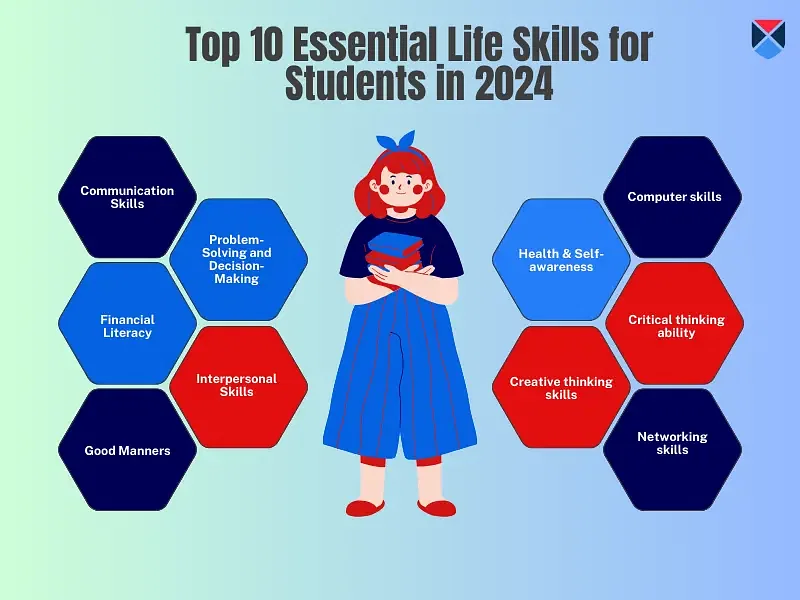
Top 10 Essential Life Skills for Students in 2024
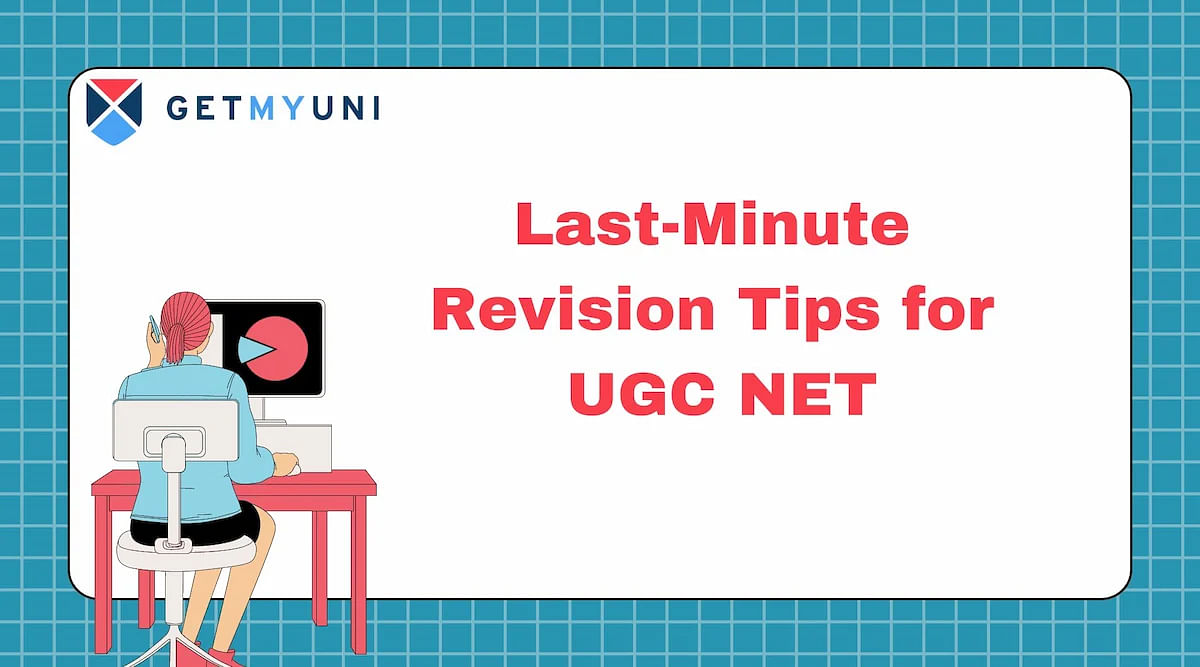
Last Minute Revision Tips for UGC NET 2024
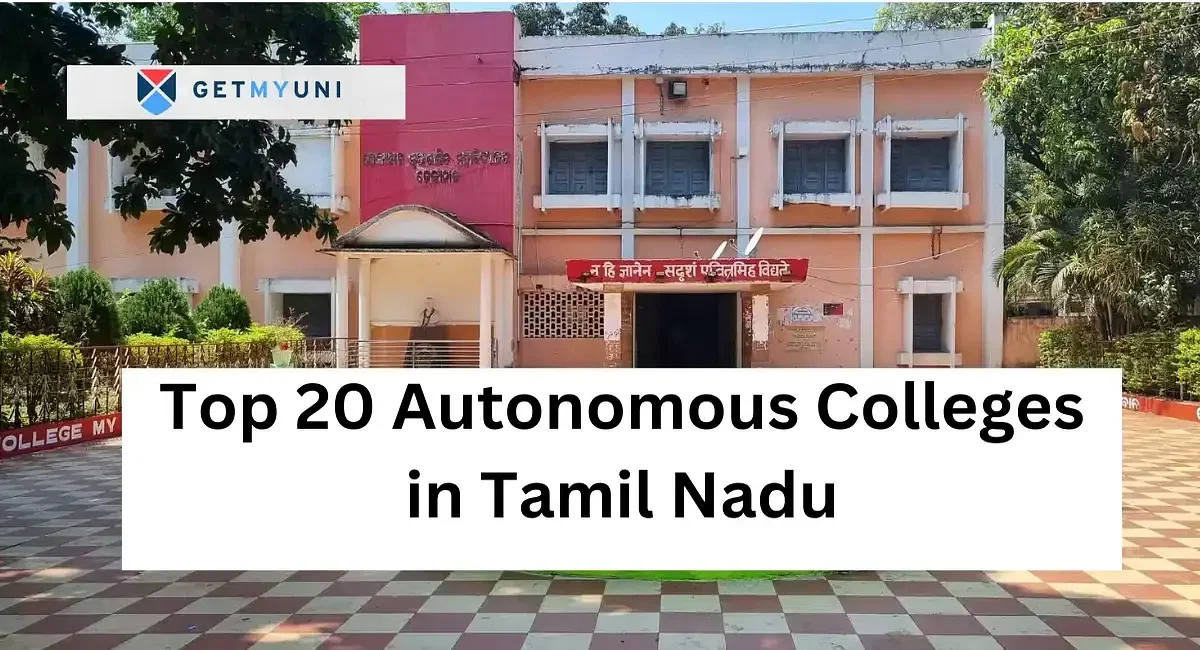
Top 20 Autonomous Colleges in Tamil Nadu

How to Become a District Collector? Step-by-Step Career Guide
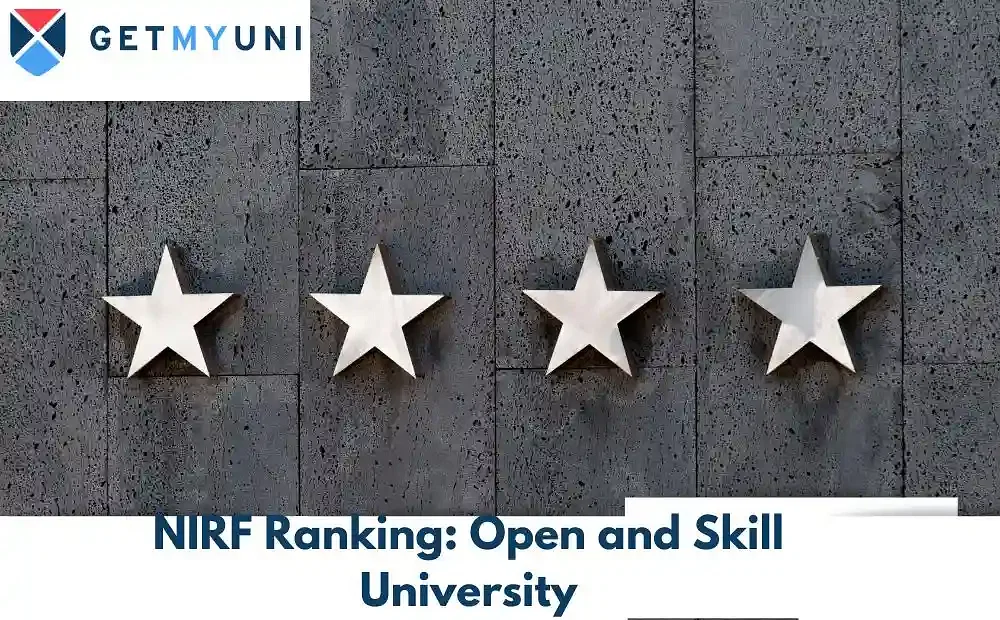
NIRF Ranking for Open and Skill University
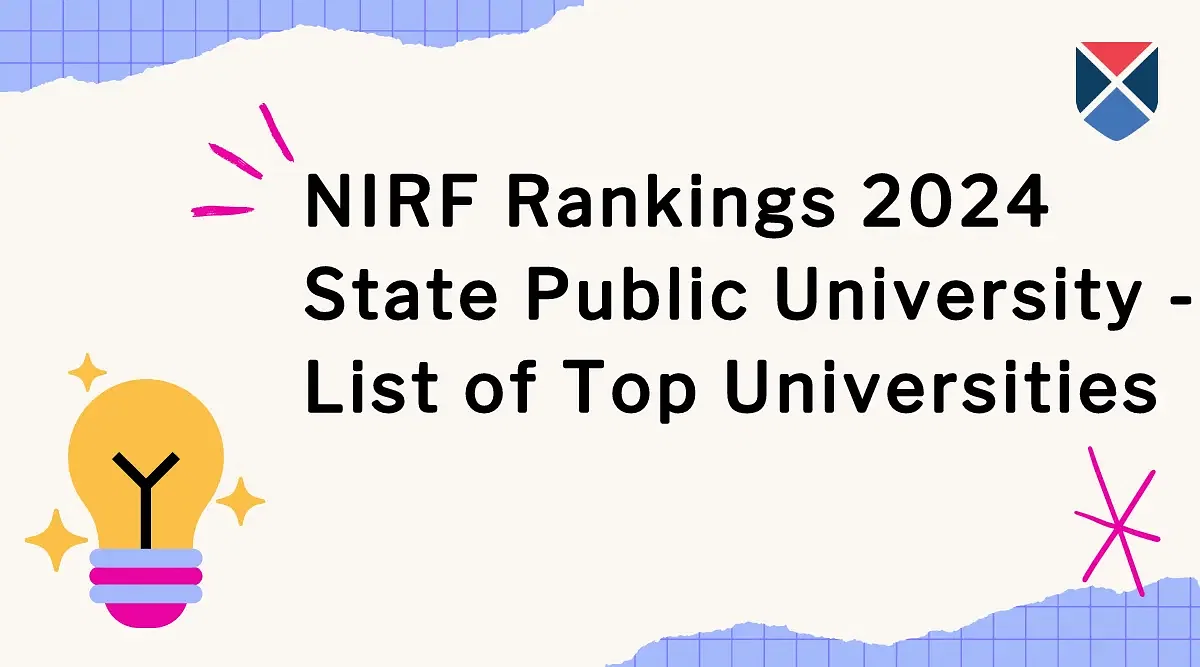
NIRF Rankings 2024 State Public University - List of Top Universities

Get Free Scholarship worth 25000 INR


Press ESC to close
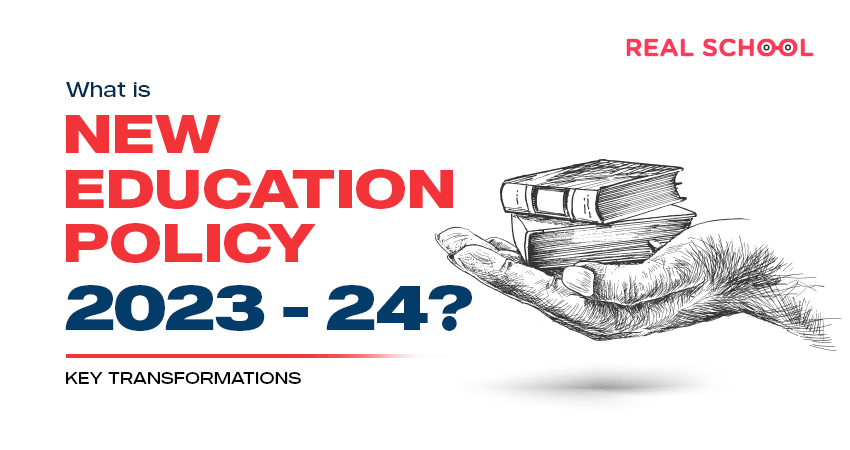
What is the New Education Policy 2023-24? Key Transformations
Education policies play a pivotal role in shaping the trajectory of a nation’s development by influencing its educational landscape. The New Education Policy 2023-24 , introduced with the aim of transformative changes, has sparked considerable interest and discussions. In this exploration, we delve into the key transformations outlined in the policy and their potential implications on the educational ecosystem.
What is the New Education Policy 2023-24?
Core objectives of the new education policy 2023-24.
- Fostering holistic development of students : One of the fundamental objectives of the New Education Policy is to foster the holistic development of students. It emphasizes not only academic excellence but also the development of critical thinking, creativity, and ethical values.
- Emphasizing flexibility and choice in education : The policy recognizes the diverse learning styles and aspirations of students. By promoting flexibility and choice in education, it aims to provide personalized learning experiences that cater to individual strengths and interests.
- Aligning education with the needs of the evolving job market : To prepare students for the dynamic job market, the policy seeks to align education with industry requirements. It emphasizes the development of practical skills, entrepreneurship, and a deep understanding of emerging technologies.
Structural Changes in School Education
- Redefining the school curriculum and assessment methods : The New Education Policy envisions a revamped school curriculum that emphasizes experiential learning, critical thinking, and a multidisciplinary approach. Assessment methods are also expected to shift towards competency-based evaluations, moving away from traditional rote memorization.
- Introducing innovative pedagogical approaches : To make learning more engaging and relevant, the policy encourages the adoption of innovative pedagogical approaches. This includes project-based learning, collaborative activities, and the integration of real-world applications into the curriculum.
- Strengthening the integration of technology in classrooms : Recognizing the role of technology in modern education, the policy advocates for the increased integration of digital tools in classrooms. This includes leveraging online resources, interactive learning platforms, and technology-enabled assessments.
Higher Education Reforms
- Transforming the higher education system for global competitiveness : The policy aims to elevate the status of Indian higher education on the global stage. This involves initiatives to enhance the quality of education, research infrastructure, and global collaborations with prestigious institutions.
- Promoting multidisciplinary education and research : Breaking away from siloed disciplines, the policy promotes multidisciplinary education and research. It encourages students to explore diverse fields and fosters collaboration between different academic disciplines.
- Enhancing accessibility and inclusivity in higher education : To ensure equal opportunities for all, the policy focuses on enhancing accessibility and inclusivity in higher education. This includes measures to support students from diverse backgrounds, including those with disabilities.
Also Read: How Do You Start Homeschooling For Your Child?
Other Initiatives in the New Education Policy 2023-24
Skill development initiatives.
- Emphasizing skill-based learning from an early age : The policy recognizes the importance of skill development alongside traditional academic pursuits. It encourages skill-based learning from an early age, aiming to equip students with practical skills relevant to their chosen career paths.
- Aligning skill development with industry requirement s: To bridge the gap between education and employment, the policy seeks to align skill development initiatives with industry requirements. This involves close collaboration between educational institutions and industries to identify and address skill gaps.
- Facilitating seamless transitions from education to employment : In line with global trends, the policy places a strong emphasis on facilitating seamless transitions from education to employment. This involves providing students with the necessary skills, career guidance, and internship opportunities.
Language and Cultural Emphasis
- Encouraging multilingualism and cultural diversity : Recognizing India’s rich linguistic and cultural diversity, the policy encourages multilingualism. It promotes the inclusion of regional languages in education, fostering a deeper connection to cultural heritage.
- Integrating regional languages into the curriculum : The policy advocates for the integration of regional languages into the curriculum, not only as subjects of study but also as mediums of instruction. This aims to preserve and promote linguistic diversity.
- Promoting a deeper understanding of India’s cultural heritage : Beyond linguistic diversity, the policy emphasizes the importance of understanding India’s cultural heritage. It encourages educational institutions to incorporate cultural studies and activities that foster a sense of pride and appreciation for the nation’s diverse traditions.
Teacher Training and Professional Development
- Revamping teacher training programs for contemporary needs : Recognizing the pivotal role of educators, the policy emphasizes the revamping of teacher training programs. This includes equipping teachers with modern teaching methodologies, technology integration skills, and strategies for addressing diverse learning needs.
- Prioritizing continuous professional development for educators : The policy acknowledges the dynamic nature of education and the need for continuous professional development for educators. It encourages institutions to provide opportunities for teachers to upgrade their skills and stay abreast of the latest developments in their fields.
- Recognizing and rewarding excellence in teaching : In a bid to elevate the status of teaching as a profession, the policy promotes the recognition and rewarding of excellence in teaching. This involves establishing mechanisms to identify and celebrate exemplary educators who make significant contributions to student learning.
Assessment and Examination Reforms
- Moving towards competency-based assessments : Departing from traditional rote memorization, the policy advocates for competency-based assessments. This shift aims to evaluate students based on their understanding of concepts, critical thinking abilities, and practical application of knowledge.
- Reducing the emphasis on rote memorization : To encourage a deeper understanding of subjects, the policy seeks to reduce the emphasis on rote memorization in assessments. This aligns with the broader objective of nurturing analytical thinking and creativity among students.
- Introducing a more flexible and inclusive examination system : The policy envisions a more flexible and inclusive examination system. This includes options for students to choose subjects based on their interests, multiple opportunities for assessments, and a focus on evaluating a broad spectrum of skills.
Challenges and Criticisms in the New Education Policy 2023-24
- Addressing concerns about the implementation of the policy : While the New Education Policy 2023-24 holds transformative potential, challenges related to its effective implementation have been raised. Addressing concerns about infrastructure, teacher preparedness, and equitable access to opportunities is crucial for the success of the policy.
- Balancing the aspirations of diverse stakeholders : Education policies often need to balance the aspirations of diverse stakeholders, including students, parents, educators, and policymakers. Striking the right balance to meet the varied needs and expectations is a delicate yet crucial task.
- Navigating potential hurdles in the transition phase : The transition phase from existing educational frameworks to the proposed changes can present hurdles. Navigating these challenges requires strategic planning, effective communication, and a phased approach to implementation.
In conclusion, the New Education Policy 2023-24 holds the promise of ushering in a new era of education in India. By addressing key areas such as holistic development, flexibility, skill development, and cultural inclusivity, the policy aims to create a robust educational ecosystem. Encouraging active participation and feedback from stakeholders will be pivotal in refining and implementing the policy effectively.
Know more from the expert for your child education – The Real School
Q1: How does the New Education Policy 2023-24 promote flexibility in education? A: The policy promotes flexibility by allowing students to choose subjects based on their interests, encouraging multidisciplinary education, and providing options for assessments that cater to diverse learning styles.
Q2: What measures are in place to enhance accessibility and inclusivity in higher education? A: The policy aims to enhance accessibility and inclusivity in higher education through measures such as supporting students from diverse backgrounds, including those with disabilities, and creating an inclusive learning environment.
Q3: How is the New Education Policy 2023-24 addressing skill development from an early age? A: The policy emphasizes skill-based learning from an early age by integrating practical skills into the curriculum, aligning skill development with industry requirements, and facilitating seamless transitions from education to employment.
Q4: What steps are being taken to recognize and reward excellence in teaching? A: The policy encourages the recognition and rewarding of excellence in teaching by establishing mechanisms to identify and celebrate exemplary educators. This includes acknowledging contributions to student learning and professional development.
Q5: How can stakeholders actively participate in the refinement of the New Education Policy? A: Stakeholders can actively participate by engaging in open dialogue, providing constructive feedback, and sharing their experiences and insights. Collaboration between parents, students, educators, and policymakers is essential for the ongoing improvement of the policy.
Also Read: What is a Montessori Preschool Program?

Leave a Reply Cancel reply
Save my name, email, and website in this browser for the next time I comment.
Share Article:
You might also like

What are the Advantages of Online Teaching at The Real School?

What is the Full Form of School?: Unveiling the Acronym


What is Math Full Form?: Cracking the Code
Other stories, what are the stages of school education in india your guide, what is the real full form of school unveiling mystery.
Forgot your password?
Lost your password? Please enter your email address. You will receive mail with link to set new password.
Back to login
2023 education highlights: Keeping up the momentum to transform learning
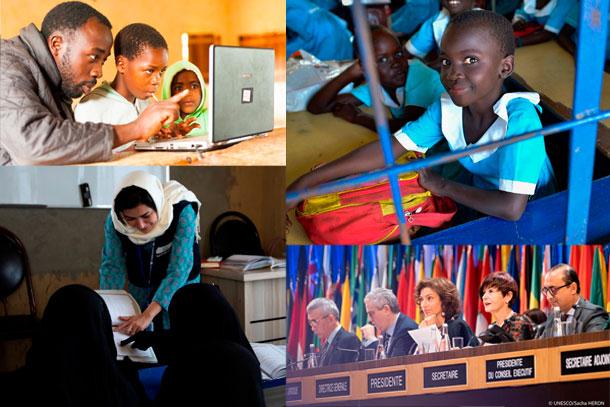
International Day of Education 2023 dedicated to Afghan girls and women
UNESCO dedicated this year's International Day of Education on 24 January to girls and women in Afghanistan who have been deprived of their right to pursue secondary and higher education. The Organization renewed its call to immediately restore their fundamental right to education. “No country in the world should bar women and girls from receiving an education,” said UNESCO Director-General Audrey Azoulay. “The international community has the responsibility to ensure that the rights of Afghan girls and women are restored without delay. The war against women must stop.”
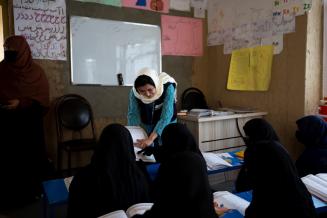
In Afghanistan’s Logar province, most girls and women are illiterate. Even before the decision of the de-facto authorities to suspend girls’ access to beyond primary education, most families did not let their girls go to school. Today, over 1,000 women and young girls aged 15 to 45 are learning how to read, write and calculate for the first time in their lives through UNESCO’s Community-based Basic General Literacy Classes. During UNESCO’s visit to two literacy classes , women and girls shared their motivations, challenges and inspirations for attending the classes. Nationwide, the Organization is currently reaching over 40,000 illiterate and semi-literate youth and adults – over 60% of whom are women – in 20 provinces.
Supporting learners and teachers in Ukraine
UNESCO and Ukraine’s Ministry of Education and Science launched an online training in digital pedagogy for 50,000 teachers, while the education of many Ukrainian students is still disrupted by the war. They are also training 15,000 school psychologists to withstand the impact of the war on the mental health of Ukrainian learners and teachers. “Since February 2022, UNESCO has continuously supported Ukrainian teachers to ensure that students continue learning in the midst of war,” said UNESCO Assistant Director-General for Education Stefania Giannini. “I pay tribute to their work, resilience and continued dedication. As the new academic year has just begun, UNESCO reaffirms its commitment to them. Because education is the cornerstone on which Ukraine's future is built.” Read more

Monitoring country commitments made at the Transforming Education Summit
The latest UNESCO data shows that the global number of out-of-school children has risen by 6 million since 2021 and now totals 250 million. The figures, compiled by the Global Education Monitoring Report and the UNESCO Institute for Statistics, reveal that education progress continues to stagnate globally. The annual finance gap for helping low and lower-middle income countries achieve their national education targets is almost US $100 billion. UNESCO remains committed to supporting countries and partners to acquire the financing needed to meet their goals. The Organization is also monitoring country commitments made at the UN Transforming Education Summit in 2022 through its new dashboard . Read more
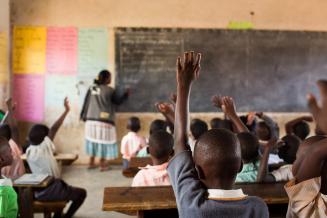
Urgent call for appropriate use of technology in learning and global guidance on generative AI in education
UNESCO’s 2023 Global Education Monitoring Report on technology in education highlights the lack of appropriate governance and regulation. It urges countries to set their own terms for the way technology is designed and used in education so that it never replaces in-person, teacher-led instruction, and supports the shared objective of quality education for all. The report proposes four questions that policy-makers and educational stakeholders should reflect upon as technology is being deployed in education. Read more
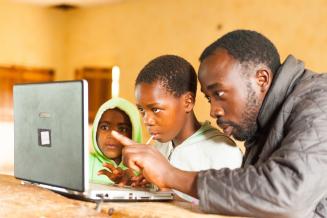
Generative artificial intelligence (GenAI) tools have far-reaching implications for education and research. Yet the education sector today is largely unprepared for the ethical and pedagogical integration of these powerful and rapidly evolving technologies, as UNESCO Assistant Director-General Stefania Giannini reiterated in her think piece . UNESCO developed the first-ever global guidance on GenAI in education. Launched during UNESCO’s flagship Digital Learning Week , it calls on countries to quickly implement appropriate regulations, policies, and human capacity development, for ensuring a human-centred vision of GenAI for education and research. Read more
UNESCO calls for an upgrade of teachers’ status to reduce the global shortage
“We must better value, better train and better support,” said UNESCO Director-General Audrey Azoulay on World Teachers’ Day (5 October). UNESCO and the Teacher Task Force’s first global report shows that globally, 44 million teachers are still needed to achieve the goal of providing primary and secondary education for all by 2030. This includes a demand for seven out of ten teachers at the secondary level and a need to replace over half of the existing teachers leaving the profession. The problem is not only one of funding, but also the unattractiveness of the profession. Read more
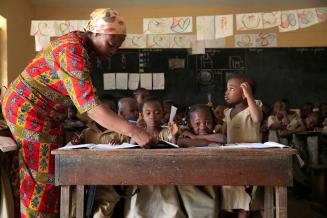
UNESCO adopts landmark guidance on education’s cross-cutting role in promoting peace
On 20 November 2023, the 194 UNESCO Member States adopted the Recommendation on Education for Peace, Human Rights and Sustainable Development at UNESCO’s General Conference . This is the only global standard-setting instrument that lays out how education should be used to bring about lasting peace and foster human development through 14 guiding principles. For the past two years, UNESCO has been revising this visionary tool to ensure it responds to today's greatest challenges and future shocks. Read more
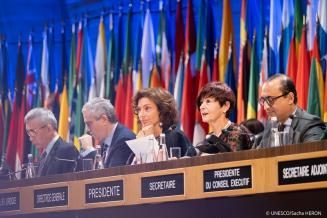
UNESCO at COP28: Making education the long-term solution to the climate crisis
UNESCO is accelerating climate change education and greening initiatives through its coordinating role of the Greening Education Partnership and extensive work on education for sustainable development . At COP28, UNESCO played a key role in the various dialogues on accelerating climate change education and emphasized the significance of sustainable learning in fostering long-term solutions for the climate crisis. The Organization presented at the COP the drafts of two new normative and groundbreaking resources: A global curriculum guidance for climate change education; and a green schools quality standards, which will be finalized and rolled-out next year. A major highlight of the gathering was launch of the Declaration for Climate Change and Education , focused on adaptation, mitigation and investment – which was signed and endorsed by 41 countries. Read more

Exploring how rights should adapt as education evolves
The world has considerably changed since the key treaties on the right to education were conceived and adopted over half a century ago. Education can no longer be only confined to traditional classrooms and textbooks but has expanded to encompass lifelong and life-wide learning. UNESCO's Initiative on the evolving right to education launched its formal dialogue in December to explore how international human rights instruments can be reinforced and further developed to address today's needs and challenges. Read more
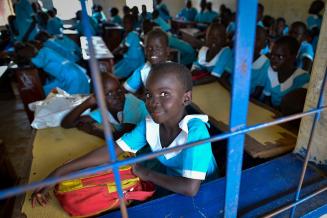
Looking into 2024, the International Day of Education will be celebrated on 24 January under the theme “learning for lasting peace”. The world is seeing a surge of violent conflicts paralleled by an alarming rise of discrimination, racism, xenophobia, and hate speech. An active commitment to peace is more urgent today than ever: Education is central to this endeavor, as underlined by the UNESCO Recommendation on Education for Peace, Human Rights and Sustainable Development .
Key UNESCO publications on education in 2023
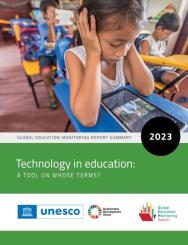
- Greek (modern)
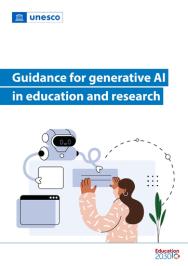
Related items
- Topics: Display
Other recent news

Explore Our Affordable Courses
- UPSC Online
- UPSC offline and Hybrid
- UPSC Optional Coaching
- UPPCS Online
- BPSC Online
- MPSC Online
- MPPSC Online
- WBPSC Online
- OPSC Online
- UPPCS Offline Coaching
- BPSC Offline Coaching
- UPSC Test Series
- State PSC Test Series
- DAILY CURRENT AFFAIRS
- SUBJECT WISE CURRENT AFFAIRS
- DAILY EDITORIAL ANALYSIS
- DAILY CURRENT AFFAIRS QUIZ
- Daily Prelims(MCQs) Practice
- Daily Mains Answer Writing
- Prahaar (Mains Wallah) 2024
- Mains Wallah – Q&A Bank
- Udaan Prelims Wallah Static booklets 2024
- Udaan 500+ for Prelims Current Affairs 2023
- NCERT Wallah Books
- Prelims Marks Boosters 2024
- Prelims PYQs
- Optionals PYQs
- NCERT Notes
- Udaan Notes
- UPSC Prelims Answer Key
- UPSC Syllabus

- Offline Centres
- UDAAN Notes
- UPSC Prelims PYQs
- UPSC Mains PYQs
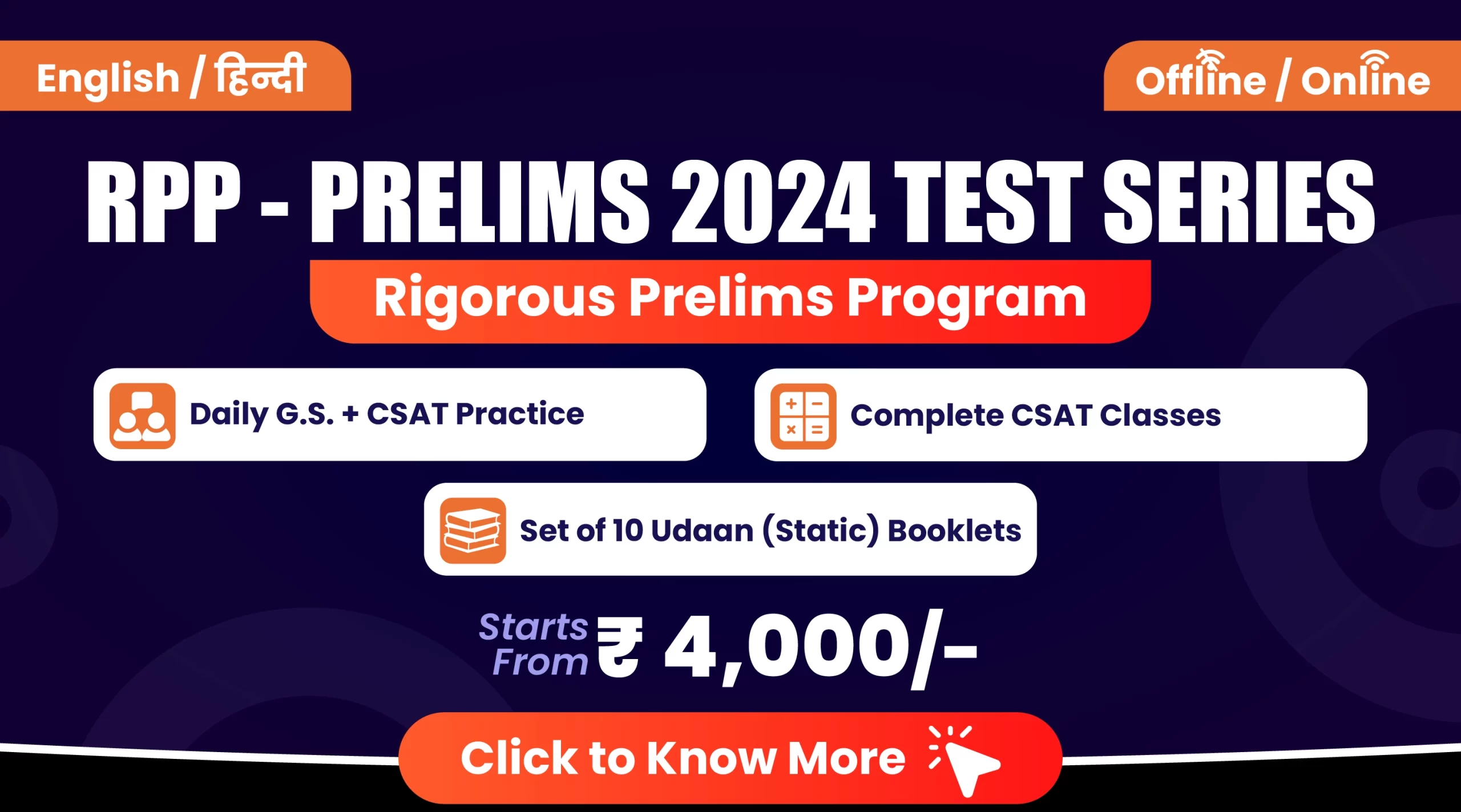
Parliament Panel Insights into New Education Policy 2023 | PWOnlyIAS 2023
- This article is based on an Editorial “ What are the findings of the Parliament panel on the New Education Policy? ” which was published in the Hindu. Recently, the Parliament Standing Committee on Education tabled a report on the “Implementation of the New Education Policy 2023 in Higher Education.”
| New Education Policy 2023, PM Schools for Rising India (PM SHRI), e-VIDHYA, NIPUN Bharat and MEME. New Education Policy 2023, its significance & issues, Findings of Parliament Standing Committee on New Education Report on , Associated government initiatives like PM Schools for Rising India (PM SHRI), e-VIDHYA, NIPUN Bharat and MEME. |
|---|
What Is the Progress in Implementing the New Education Policy 2023 in Higher Education?
- Implementation: The report assesses the salient features of the New education policy 2023 implementation in the higher education sector and the progress made so far.
- Out of which 70% are governed under the State Acts , 18% are governed by the Central Government.
- Enrolment: It has further been informed that 94% of students are enrolled in State/private Institutions while 6% are enrolled in Central Institutions.
- GER: It is calculated by dividing the number of students enrolled in higher education out of the total population in the relevant age group of 18-23 years.
What is the Current Implementation Status of the New Education Policy 2023?
- Fruitful Progress : Through various appreciable measures like PM Schools for Rising India (PM SHRI), e-VIDHYA, NIPUN Bharat etc. the implementation of the New education policy 2023 is progressing on course with its vision to transform the higher education system to be more inclusive, flexible, and aligned with global standards.
- Best Practices – Jammu and Kashmir (J&K) : The UT of J&K is one of the first in the country to implement NEP 2020 from the academic session 2022 in all the Higher Education Institutions.
- Focus on Creativity : New education policy 2023 places thrust on developing a student’s ‘Creative Potential’ based on higher-order cognitive capacities and cultivating innovation and creativity in learners through industry-institution linkages and collaborative programs.
- Internationalization of Education : Freedom being given to Indian universities to set up campuses in other countries and initiate start-up incubation centers and from among the top 100 universities in the world will be facilitated to operate in India.
- Implementation of the Multi Entry and Multiple Exit (MEME) options within the framework of the National Education Policy (NEP) is a vital component of New education policy 2023, offering students greater flexibility and choice in their educational pathways.
Also read: Government Schemes 2023
What are the Issues Associated With New Education Policy 2023?
- Accessibility : Limited access to higher education in socio-economically disadvantaged areas due to financial barriers, geographical constraints and stereotype threat faced by students of marginalized sections etc.
- Multiple Entry And Multiple Exit (MEME): According to the report, Indian institutions are likely to face several issues in implementing the MEME system under the new education policy 2023.
- Linguistic Issue: Most of the HEIs primarily use English as a medium of instruction and there is a lack of HEIs that teach in local languages .
- According to the Economic Survey 2022-23 , total education outlay added up to 2.9% of the GDP .
Also read: India’s GDP Growth Rate: India GDP Growth Rate, Trends and Analysis
What are the Way forwards for implementing the New Education Policy 2023?
- Fulfillment of Goals : By 2030, every district in the country should have at least one multidisciplinary HEI and that the GER in higher education, including vocational education, should be increased to 50% by 2035.
- Research and Innovation : There is steady progress in the field of higher education and specific impetus is required in new education policy 2023 to be assigned to factors like anusandhan (research ), that can help the country’s ranking in patent filing .
- Effective Funding : Higher Education Financing Agency (HEFA) needs to diversify its funding sources beyond government allocations and explore partnerships with private sector organizations, philanthropic foundations, and international financial institutions.
- Digitisation of Education : The creation of a National Educational Technology Forum (NETF) can go a long way in expansion of digital infrastructure to make the country a Global Knowledge Hub .
- Inclusive Education : Implementation of certain specific initiatives aimed at enhancing access to education for marginalised communities in accordance with the New Education Policy 2023 through various initiatives like comprehensive awareness campaigns, infrastructure development, teacher training and recruitment, scholarship and financial support, digital inclusivity, etc.
- Implementation of a standardized Credit Accumulation and Transfer (CAT) system allows students to earn and transfer credits seamlessly across institutions.
Parliament panel’s findings on the New Education Policy 2023 highlight both progress and challenges. While there’s commendable progress in implementing the policy with initiatives like PM Schools and internationalization. However the issues such as limited accessibility, linguistic barriers, and funding gaps need urgent attention. To achieve the envisioned transformation of Indian higher education, we need a holistic approach that addresses these concerns and fosters research, innovation, and ensure smooth educational pathways for all students.
| Q. Which of the following provisions of the Constitution does India have a bearing on Education? (2012)
(a) 1 and 2 only
Discuss the main objectives of Population Education and point out the measures to achieve them in India in detail. (GS Paper 2; UPSC Mains 2021) |
|---|
To get PDF version, Please click on "Print PDF" button.

- Recent Post
- Related Post
- Most Viewed Post

Reality of Reel Life, Exploitation As a Structural Problem
Investing in Persons With Disabilities
Centre announces Unified Pension Scheme: How will UPS differ...
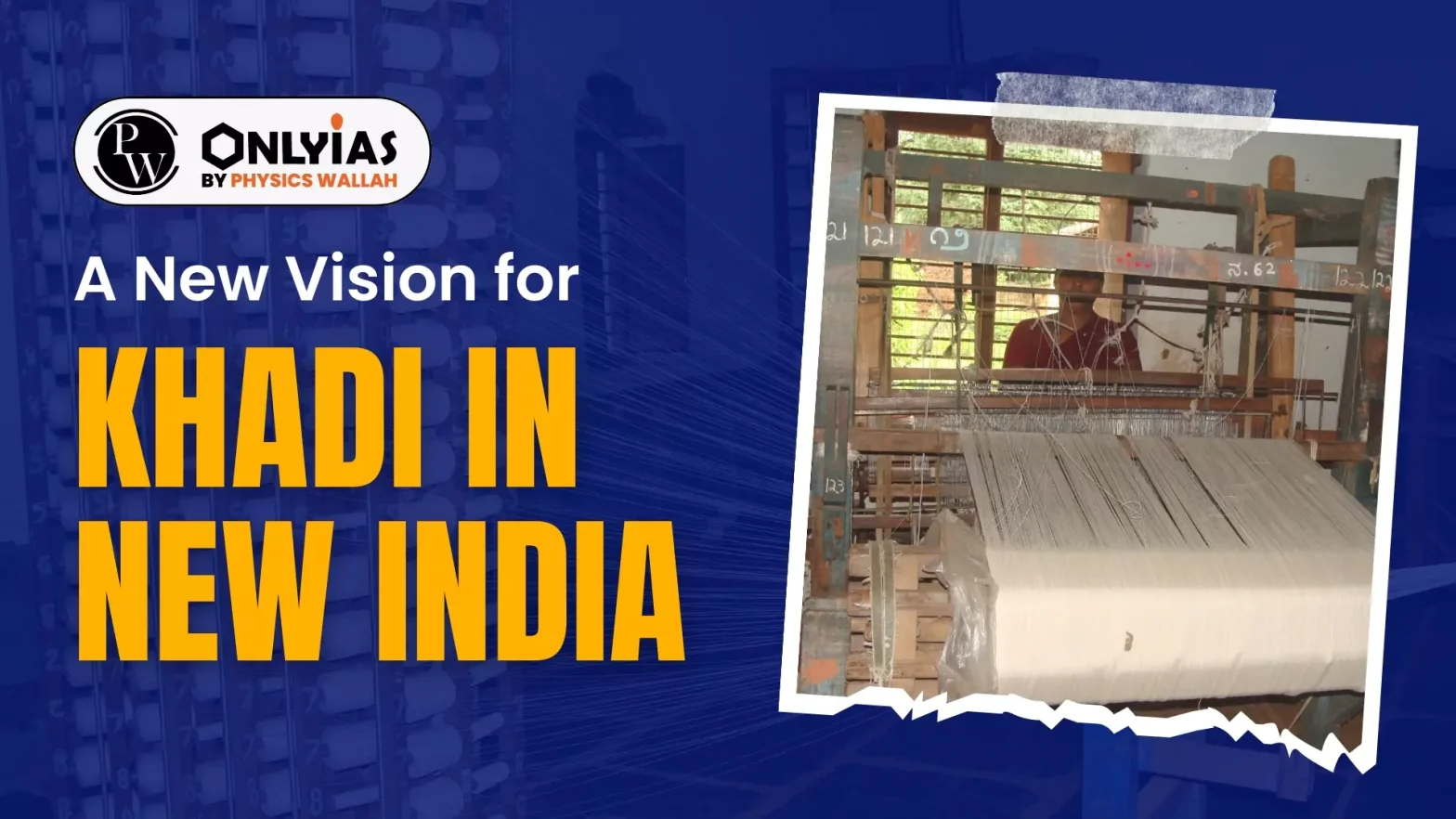
A New Vision for Khadi in New India
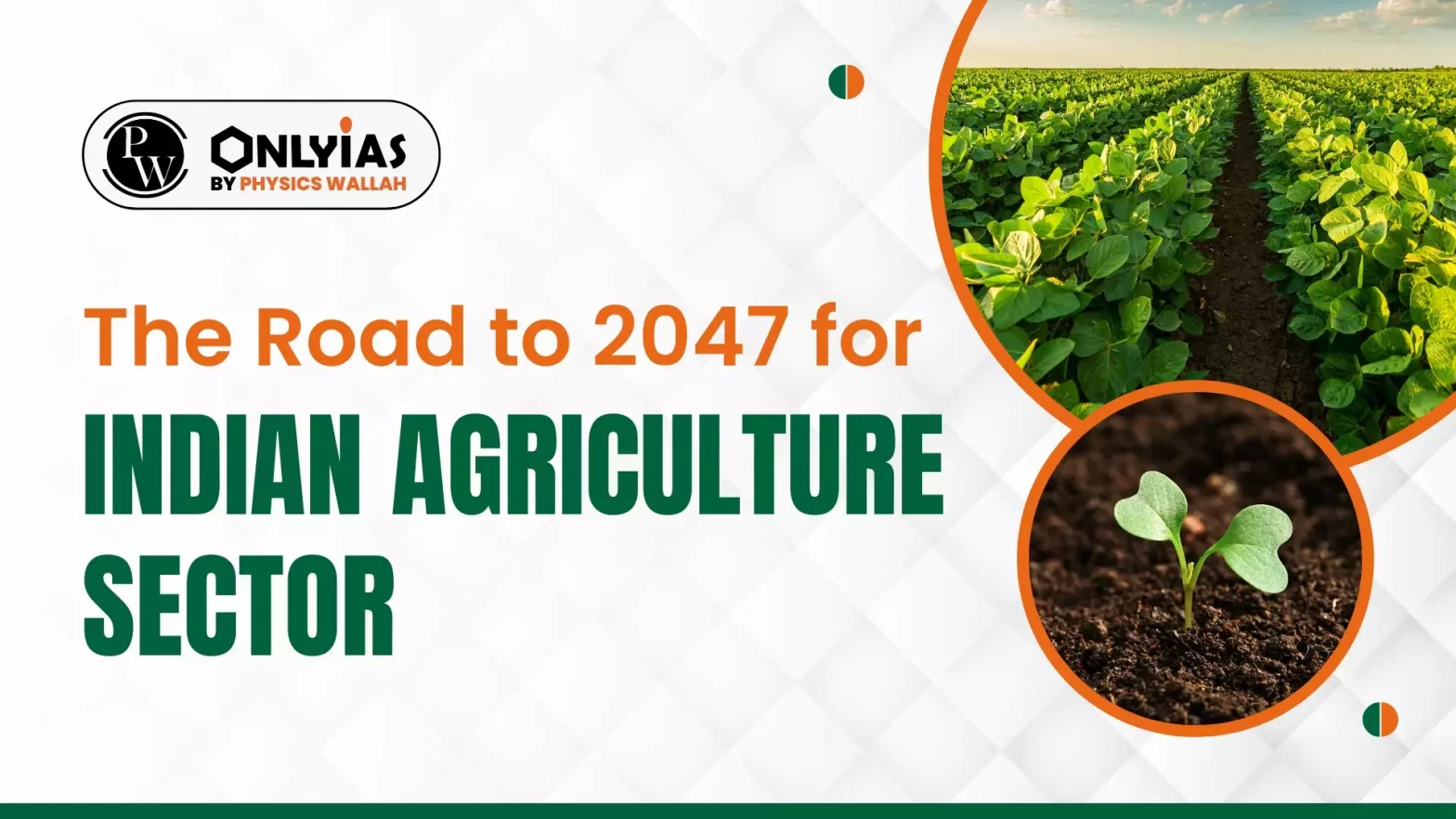
The Road to 2047 for Indian Agriculture Sector
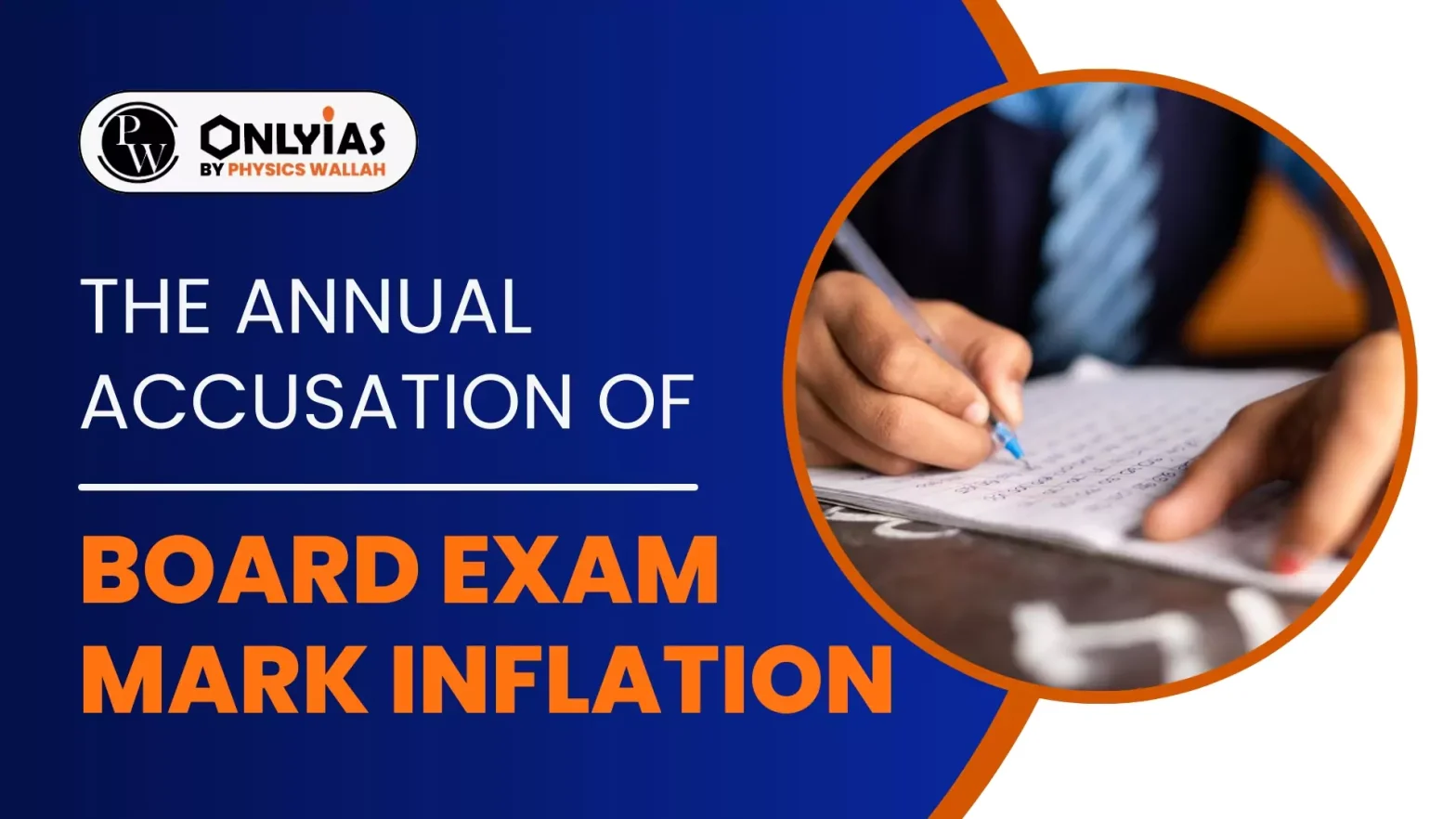
The Annual Accusation of Board Exam Mark Inflation
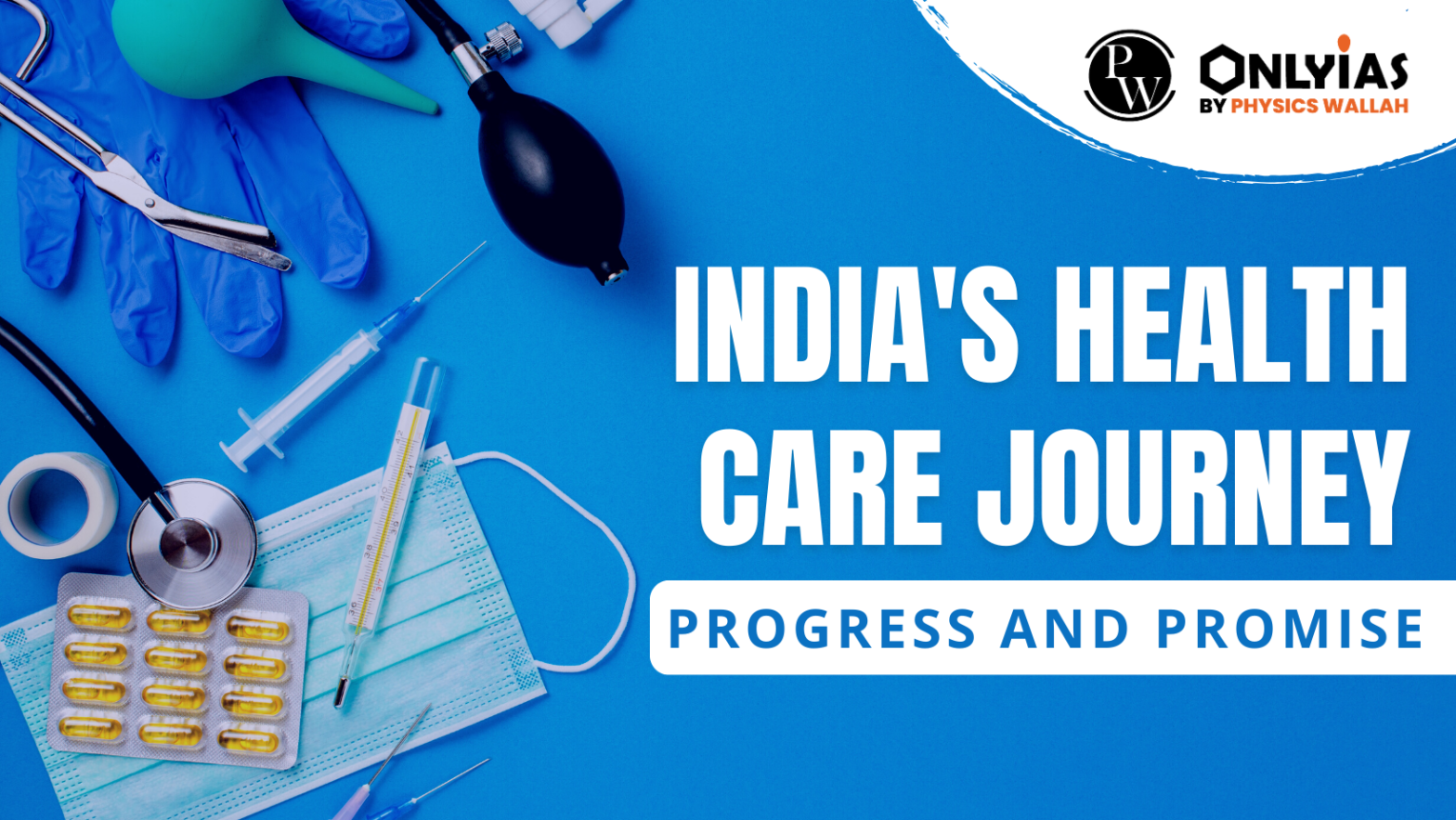
India’s Health Care Journey: Progress and Promise | PW...

Patient Safety Rights Charter: A Global Initiative for Safer...

ILO Report On Occupational Safety And Health (OSH)
Outreach to diaspora and statesmanship, india and the artemis accords, laying the foundation for a future-ready digital india, latest comments, recent editorial.
Reality of Reel Life, Exploitation As a Structural...
Centre announces Unified Pension Scheme: How will ...
Popular current affairs
News in Shorts: 26 August 2024
Justice J.S. Verma Committee on Dealth Penalty for...
Frequent Mass Wasting
BioE3 (Biotechnology for Economy, Environment and ...
Atacama Salt Flat Sinking from Lithium Mining
India-Singapore Ministerial Roundtable (ISMR)
Our Courses
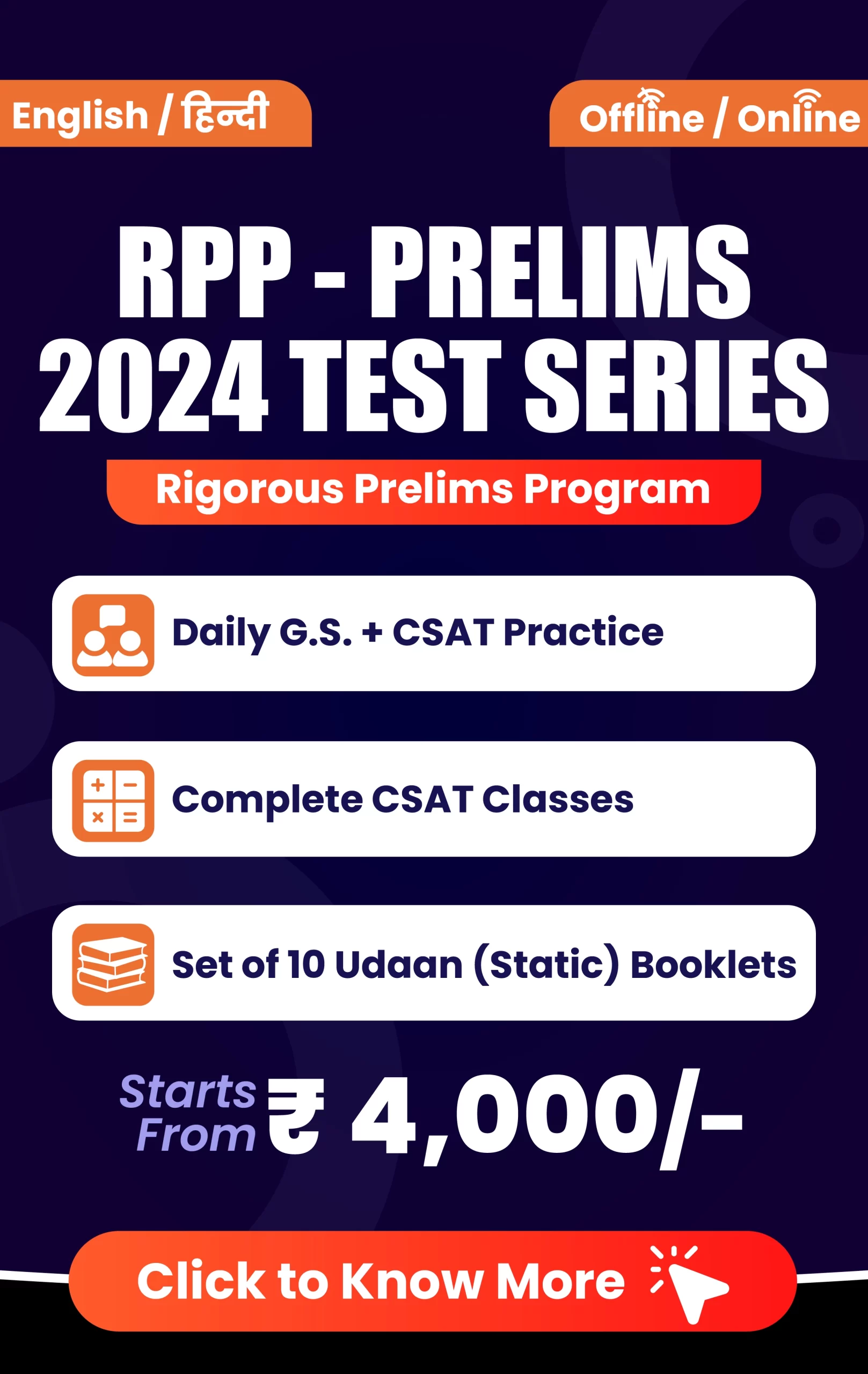
THE MOST LEARNING PLATFORM
Learn From India's Best Faculty

Our Initiatives
Beginner’s roadmap, quick links.

PW-Only IAS came together specifically to carry their individual visions in a mission mode. Infusing affordability with quality and building a team where maximum members represent their experiences of Mains and Interview Stage and hence, their reliability to better understand and solve student issues.
Subscribe our Newsletter
Sign up now for our exclusive newsletter and be the first to know about our latest Initiatives, Quality Content, and much more.
Contact Details
G-Floor,4-B Pusha Road, New Delhi, 110060
- +91 9920613613
- [email protected]
Download Our App
Biginner's roadmap.
G-Floor,4-B Pusa Road, New Delhi, 110060
SUSCRIBE NOW FORM
Fill the required details to get early access of quality content..
Join Us Now
(Promise! We Will Not Spam You.)
CURRENT AF.
<div class="new-fform">
Select centre Online Mode Hybrid Mode PWonlyIAS Delhi (ORN) PWonlyIAS Delhi (MN) PWonlyIAS Lucknow PWonlyIAS Patna Other
Select course UPSC Online PSC ONline UPSC + PSC ONLINE UPSC Offline PSC Offline UPSC+PSC Offline UPSC Hybrid PSC Hybrid UPSC+PSC Hybrid Other
</div>


The New Education Policy 2023-2024: A Comprehensive Overview
- Post author: admin
- Post published: April 29, 2023
- Post category: News
The Indian government has as of late declared another training strategy that will happen in 2023-2024. The goal of this policy is to bring the country’s education system into line with international standards. We will examine the new education policy and its implications in greater detail in this article.

Table of Contents
Introduction
Background of the new education policy.
The Indian government has taken the initiative to change the country’s education system with its new education policy . In 1986, a new education policy was created, and it was updated in 1992. India’s socioeconomic and cultural landscape has undergone significant shifts over the past few decades, necessitating a revision of the education policy. A committee led by prominent educator Dr. K. Kasturirangan drafted the new policy, which was approved by the Union Cabinet in 2020. The policy aims to bring the Indian education system into line with international standards and address the issues of the 21st century.
Goals of the new training strategy
The new schooling strategy has a few goals, which are pointed toward changing the school system of India. A portion of the key targets include:
- Education for every person : The goal of the policy is to make sure that every child in India can get an education, no matter how much money they have.
- The importance of basic literacy and math skills: The arrangement lays accentuation on guaranteeing that all kids in elementary school accomplish essential degrees of proficiency and numeracy.
- Changing the pedagogy and curriculum of schools: The policy calls for reorganizing the school curriculum to encourage experiential learning and make it more comprehensive and integrated.
- Concentrate on vocational training: The arrangement expects to coordinate professional training into the standard education policy, so understudies can gain the abilities expected to enter the labor force.
- The promotion of regional languages and multilingualism: The policy aims to encourage multilingualism in schools and acknowledges the significance of regional languages.
- Education technology use: The policy places an emphasis on how technology can be used in education to make education more accessible and improve learning outcomes.
- Teachers’ professional development: The policy makes a number of suggestions to enhance the quality of teacher education and acknowledges the significance of teacher training.
In general, the new policy on education seeks to establish a robust and all-encompassing educational system that equips students for the challenges of the twenty-first century.
Key Changes
Introduction of a new 5+3+3+4 education structure.
One of the critical highlights of the new instruction strategy is the presentation of another 5+3+3+4 design for school training. This structure, which takes the place of the 10+2 structure that is currently in place, aims to provide a more comprehensive and integrated approach to education.
The foundational stage of education focuses on play-based and activity-based learning for the first five years of education (ages 3 to 8). The preparatory stage lasts for three years, from the ages of 8 to 11, and focuses on developing conceptual understanding and higher-order thinking abilities. The middle stage lasts for the next three years when students between the ages of 11 and 14 can choose from a wide range of subjects and participate in extracurricular activities. The final four years, from the ages of 14 to 18, are the secondary stage, where students can choose from a variety of subjects and career paths.
Students will be able to explore their interests and strengths thanks to the new structure, which aims to provide a more adaptable and student-centered approach to education. Additionally, it aims to promote experiential and activity-based learning while reducing the emphasis on rote learning. The new construction is supposed to achieve a change in perspective in the Indian school system and get ready understudies for the difficulties of the 21st 100 years.
Reduction in the emphasis on board tests
The new training strategy perceives that the overemphasis on onboard tests has had adverse results on understudies, like pressure and uneasiness. As a result, it suggests moving away from board exams and toward a more comprehensive and multidisciplinary approach to assessment.
Under the new arrangement, understudies will be evaluated on their abilities and capabilities, as well as their scholarly information. The strategy proposes the presentation of a scope of developmental and summative evaluations all through the scholastic year, which will give a more complete image of the understudy’s learning progress. In addition, the policy proposes making board exams only one of several considerations for admission to higher education institutions, lowering the stakes associated with them.
It is anticipated that the focus of education will shift away from rote learning and toward a more holistic and experiential approach as a result of the reduction in the importance of board exams. It is likewise expected to decrease the pressure and tension related with board tests, which have been a main issue for understudies and guardians the same. In general, the goal of putting less emphasis on board exams is to make education more student-centered and inclusive.
Integration of vocational education
The new policy on education acknowledges the significance of vocational education in preparing students for the workforce and fostering economic expansion. As a result, it suggests incorporating vocational education into the standard educational system.
Under the new strategy, professional training will be presented as a different stream in optional schools (grades 9-12) and will be accessible as an elective for understudies in grades 6-8. In order to equip students with skills that are in high demand on the job market, vocational courses will be developed in collaboration with industry professionals.
Students are anticipated to gain practical skills and hands-on training as a result of the integration of vocational education, which will prepare them for the workforce. It is likewise expected to advance business and urge understudies to seek after vocations in fields that line up with their inclinations and assets.
In general, the coordination of professional schooling is a critical stage towards advancing a more comprehensive and comprehensive schooling system that plans understudies for the difficulties of the 21st 100 years. It acknowledges the significance of vocational skills in fostering economic expansion and providing students with opportunities to pursue fulfilling careers.
User multilingualism and the promotion of regional languages
The new education policy acknowledges the significance of multilingualism in fostering a sense of national unity and cultural diversity. As a result, it suggests that regional languages be taught in schools and that multilingualism be encouraged.
Students will be able to learn three languages under the new policy: English and two Indian languages, one of which must be a regional language. This is pointed toward advancing multilingualism and empowering understudies to foster a more profound comprehension and enthusiasm for various societies.
The proposal to establish a National Institute for Pali, Persian, and Prakrit also acknowledges the significance of promoting regional languages. The purpose of this institute will be to ensure the preservation and promotion of regional languages as well as to encourage research and development in them.
The advancement of multilingualism and provincial dialects is supposed to decidedly affect understudies’ mental turn of events and social mindfulness. It is likewise expected to advance semantic variety and support the safeguarding and advancement of territorial dialects, which are a significant piece of India’s rich social legacy.
By and large, the advancement of multilingualism and local dialects is a huge step towards advancing a more comprehensive and socially different school system that plans understudies for the difficulties of the 21st 100 years.
Presentation of coding as a subject
The new instruction strategy perceives the developing significance of innovation and the requirement for understudies to be furnished with advanced abilities. As a result, it suggests teaching coding as a subject in schools.
Coding will become a subject in secondary school (grades 6–8) and an elective in higher secondary school (grades 9–12) under the new policy. The coding curriculum will be developed in collaboration with industry professionals and will aim to teach students the fundamentals of computer programming and coding.
It is anticipated that the introduction of coding as a subject will improve students’ digital skills and prepare them for the demands of the workforce of the 21st century. Students’ critical thinking, problem-solving abilities, and creativity will also benefit from it.
As a whole, the inclusion of coding as a subject is a significant step toward fostering an education system that is more technology-driven and better able to prepare students for the challenges of the digital age. It acknowledges the significance of digital skills in fostering economic expansion and providing students with opportunities to pursue fulfilling careers.
User Digital education initiatives
The new education policy acknowledges the transformative potential of technology in enhancing the quality of learning outcomes and expanding access to education. Accordingly, it proposes few computerized schooling drives pointed toward advancing the coordination of innovation in the school system.
The establishment of a National Educational Technology Forum (NETF) is one of the most important initiatives that the new policy calls for. The purpose of this forum will be to develop guidelines and standards for the use of technology in the classroom and to encourage the integration of technology into education.
The policy also suggests improving students’ and teachers’ digital literacy and creating digital infrastructure. This remembers the arrangement of high-velocity web availability for all schools and the improvement of computerized content and e-assets that can be gotten to by understudies and instructors.
Additionally, the policy proposes the creation of a regulatory framework for online education in recognition of its potential. This includes the creation of guidelines and standards for the accreditation of online courses and the establishment of a dedicated body for online education.
In general, the new policy’s digital education initiatives aim to increase access to high-quality education and prepare students for digital age challenges. They perceive the extraordinary capability of innovation in training and the need to coordinate innovation in the study hall to further develop learning results.
Implementation of the New Education Policy
Roadmap for execution.
- The execution of the new training strategy requires a very arranged and staged approach. As a result, the policy makes a roadmap for implementation that lays out the most important steps and timetables for putting the various initiatives it proposes into action.
- The establishment of a task force to oversee the policy’s implementation, the creation of detailed implementation plans, and the allocation of resources for the initiatives are all key phases of the implementation roadmap.
- In the first phase, the policy calls for the creation of a task force that will be in charge of ensuring that the policy is carried out properly. The creation of precise implementation plans and timelines will be the responsibility of this task force, which will be made up of experts from a variety of fields.
- The policy calls for the creation of in-depth implementation plans for each initiative it proposes in the second phase. Consultation with stakeholders and the allocation of resources for the initiatives’ implementation will be part of this.
- In the third stage, the arrangement proposes the portion of assets for the execution of the drives. This includes funding infrastructure development, teacher education, and the creation of digital content and electronic resources.
- The strategy likewise proposes the foundation of an observing and assessment system to follow the advancement of the execution of the drives and to guarantee that they are accomplishing their expected results.
In general, the goal of the new education policy’s implementation roadmap is to ensure that the various policy-proposed initiatives are implemented in a planned and phased manner. It perceives the significance of the partner conference and asset portion in the effective execution of the drives.
Allocation of funds
- The fruitful execution of the new schooling strategy will require the portion of adequate assets to help the different drives proposed under the approach. This is acknowledged in the policy, which makes a number of suggestions for ensuring that sufficient funds are allocated for the initiatives’ implementation.
- The policy calls for allocating 6% of GDP to education as one of the most important measures. This is an increment from the ongoing distribution of around 4.6% of the Gross domestic product. This expanded allotment is pointed toward guaranteeing that satisfactory assets are accessible for the execution of the different drives proposed under the arrangement.
- The policy also calls for the creation of a National Education Finance Corporation (NEFC) in addition to the increased allocation of funds. The NEFC will be tasked with obtaining funding for the implementation of the policy-proposed initiatives and mobilizing resources for education.
- In order to attract private sector investment in education, the NEFC will also be in charge of developing novel financing strategies, such as public-private partnerships.
Generally, the distribution of assets proposed under the new training strategy is pointed toward guaranteeing that sufficient assets are accessible for the execution of the different drives proposed under the approach. The establishment of the NEFC and an increased allocation of funds are significant initiatives that will contribute to the mobilization of resources and the attraction of private-sector investment in education.
Role of the central and State Governments
The Federal and State Governments must work together to make the new Education Policy a success. The strategy perceives this and proposes a structure for the job of the focal and state legislatures in the execution of the different drives proposed under the approach.
- The policy stipulates that the central government will be in charge of the overall coordination and implementation of the various policy-approved initiatives. This entails the creation of a task force to oversee the policy’s implementation, the creation of specific implementation plans, and the allocation of resources for the initiatives.
- In addition, the establishment of mechanisms for monitoring and evaluating the progress of the initiatives’ implementation and the formulation of policies and guidelines for their implementation will fall under the purview of the central government.
- The policy suggests that state governments will be in charge of putting the various initiatives into action in their respective states. This includes the allocation of resources for the initiatives’ implementation and the creation of state-specific implementation plans.
- In addition, it will be the responsibility of the state governments to develop policies and guidelines for the implementation of the initiatives in their respective states and to establish mechanisms for monitoring and evaluating the implementation’s progress.
In general, the central and state governments’ participation in the new education policy’s implementation is crucial. The active participation and coordination of both the federal and state governments are necessary for the successful implementation of the policy’s various initiatives.
A significant step toward reforming India’s educational system is the new education policy for 2023-2024. The main changes to the policy have a number of advantages for students, teachers, and schools, despite some obstacles in their way. It is essential to guarantee that the policy is effectively implemented and that all stakeholders collaborate to achieve its goals.
You Might Also Like

South Western Railway Recruitment 2023: Apply Online Now for 713 Assistant Loco Pilot, Technicians & Junior Engineers Posts

NHM Jharkhand Recruitment 2023: Apply Now Online for 810 Community Health Officer Posts

DPS Indirapuram engages in the prestigious ‘Akhil Bharatiya Shiksha Samagam’ on third anniversary of NEP 2020

- My Favorites
You have successfully logged in but...
... your login credentials do not authorize you to access this content in the selected format. Access to this content in this format requires a current subscription or a prior purchase. Please select the WEB or READ option instead (if available). Or consider purchasing the publication.
Education Policy Outlook
Education policy outlook 2022.
The annual comparative reports of the Education Policy Outlook monitor the evolution of policy landscapes mainly among the education systems of OECD Countries. The Education Policy Outlook follows the premise that knowledge of education policy is as valuable as the capacity to use it. Covering selected topics from early childhood education to adult education, the reports aim to provide a comparative understanding of how priorities and policies are evolving, and how policies can be best implemented or improved over time in their specific contexts.
- ISSN: 27076725 (online)
- https://doi.org/10.1787/4cf5b585-en
- Subscribe to the RSS feed Subscribe to the RSS feed

Transforming Pathways for Lifelong Learners
The effects of Russia’s invasion of Ukraine (with its dramatic impact on energy and food prices), the continuation of the COVID-19 pandemic, and extreme weather events in some parts of the world in 2022 are expected to reverberate into 2023. International implications for education and training include economic uncertainty and tight labour markets, ongoing digital transformation, and continued growth and influence of mass information. These trends challenge education policymakers to transform existing pathways in their countries and economies, so people can become effective lifelong learners to navigate change. Building on the OECD’s Framework of Responsiveness and Resilience in Education Policy, as well as analysis of international policies and practices from over 40 education systems implemented mainly since 2020, this report identifies three areas of policy effort that education policymakers can undertake in 2023: 1) enhancing the relevance of learning pathways; 2) easing transitions throughout learners’ pathways; and 3) nurturing learners’ aspirations. Lessons emerging from recent policy efforts are synthesised into key policy pointers for 2023. The report has been prepared with evidence from the Education Policy Outlook series—the OECD’s analytical observatory of education policy.
21 Nov 2022 126 pages English
https://doi.org/10.1787/c77c7a97-en 9789264345638 (PDF) 9789264563957 (EPUB)
Author(s): OECD
- Click to access:
- Click to access in HTML WEB
- Click to download PDF - 3.76MB PDF
- Click to download EPUB - 3.33MB ePUB

Cite this content as:
See other content on.

- Assessment Reforms in Schools
- Key themes of NEP 2020
- Our Clients
National Curriculum Framework NCF 2023 | Key Principles & Objectives of NCF 2023
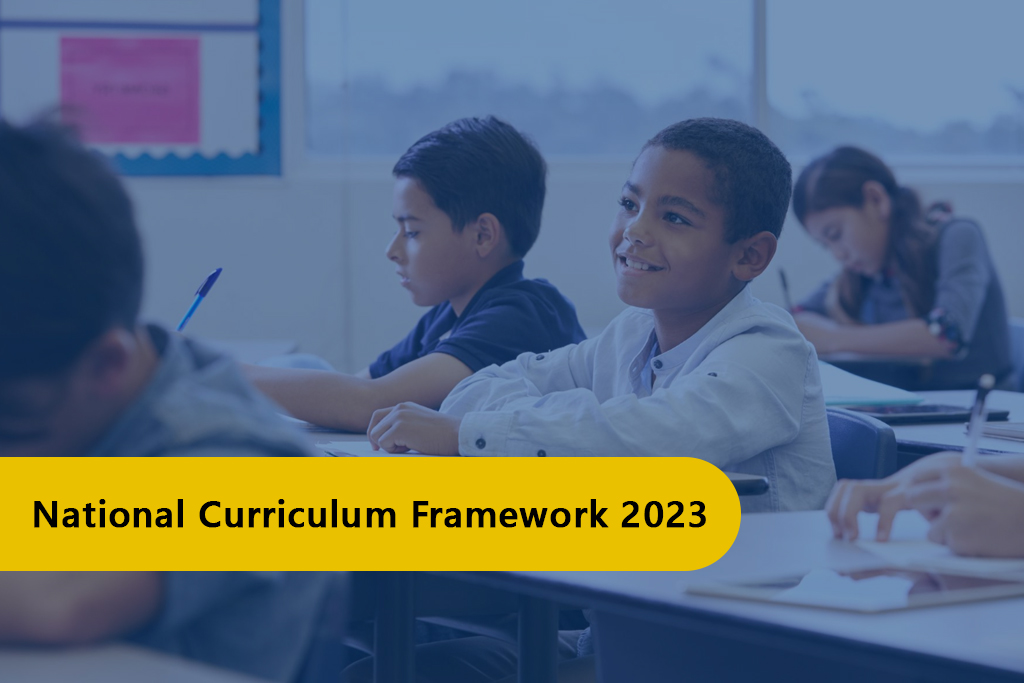
Table of contents
- Introduction
- Key Principles of NCF 2023
- Objectives of NCF 2023
National Curriculum Framework 2023:
The National Council For Education, Research, and Training(NCERT) recently released the NCF. The National Curriculum Framework for School Education (NCF) was developed to facilitate the implementation of the National Education Policy (NEP) 2020.
The first NCF was released in 1986, followed by revisions in 2000, 2005, and 2020. The modifications of the NCF have taken into account the changing educational landscape, such as new developments in academic research and technology, changing social and economic contexts, and the evolving needs of students and society.
The pre-draft of NCF 2023 is the latest one, with a few amendments aligning with the NEP’s vision, like change in board exams for 10 and 12 and assessment patterns for 3 to 8 classes.
The NCF 2023 addresses education for children from 3 to 18 years old across all Indian school system . It applies to all four Stages of the NEP 2020-envisioned 5+3+3+4 Curricular and Pedagogical Restructuring of School Education. This NCF draft focuses on the developmental perspectives, adopting different teaching methods, and curriculum changes at four different learning stages: Foundational, Preparatory, Middle, and Secondary levels.
National Education Policy 2020 and NCF
The National Education Policy 2020 (NEP 2020) aims to devise four National Curriculum Frameworks (NCFs):
- National Curriculum Framework for Early Childhood Care and Education (NCFECCE)
- National Curriculum Framework for School Education (NCFSE)
- National Curriculum Framework for Teacher Education (NCFTE)
- National Curriculum Framework for Adult Education (NCFAE)

Fundamental principles of NCF
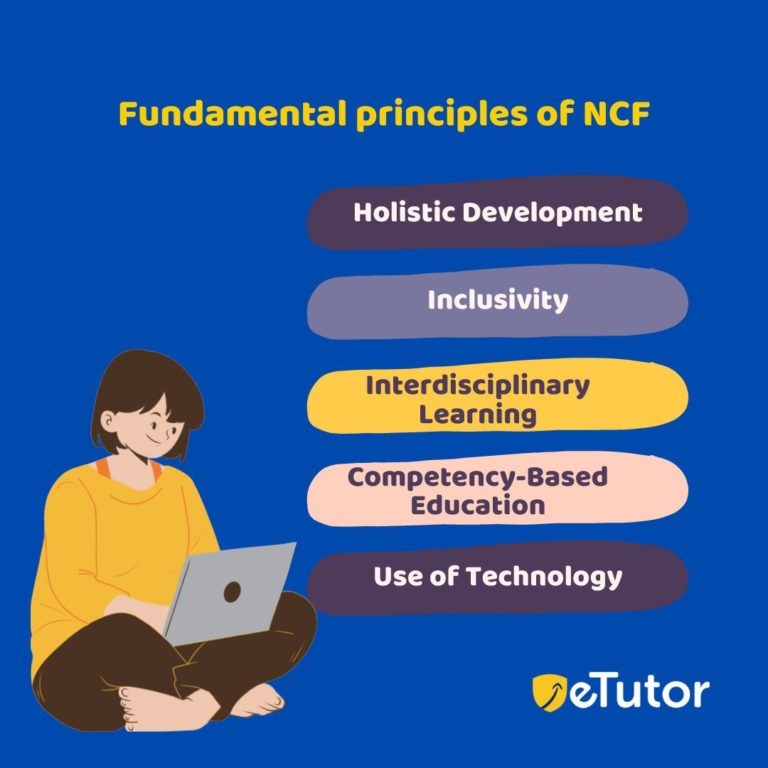
The fundamental principles of the National Curriculum Framework are:
Holistic Development: The NCF 2023 emphasizes the need for a holistic approach to education that promotes the overall development of students. It could include developing students’ physical, emotional, social, and cognitive skills.
Inclusivity: The NCF 2023 is likely to prioritize the creation of an inclusive education system that caters to the needs of all students, including those from marginalized communities. It may guide the creation of a safe and inclusive school environment free from discrimination and bias.
Interdisciplinary Learning: The NCF 2023 may advocate for multidisciplinary learning that integrates , different subject areas and encourages students to make connections between them. It could help students to develop a broader understanding of the world and prepare them for the complexities of the 21st century.
Competency-Based Education: The NCF 2023 may focus on competency-based education, emphasizing developing skills and competencies rather than mere knowledge acquisition. It could include a focus on critical thinking, creativity, communication, and problem-solving skills.
Use of Technology: The NCF 2023 may emphasize the importance of technology in education and guide how to integrate technology into teaching and learning. It could include using digital resources for teaching and learning and technology for assessments and evaluation.
Listen and communicate: Take the time to listen to your child and have regular conversations with them. Be ready to offer advice and assistance and express interest in their ideas and feelings.

Objectives of NCF
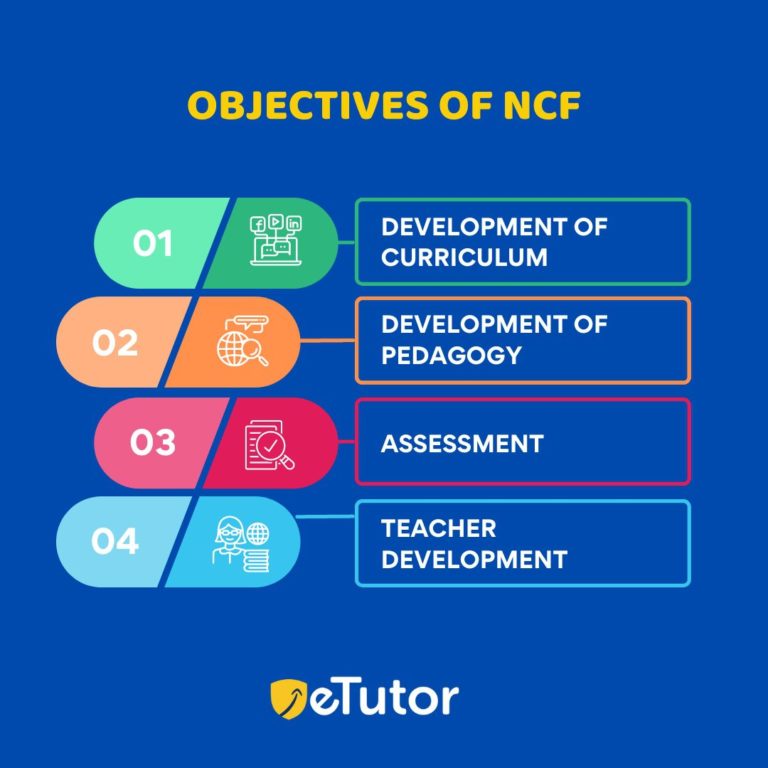
Development of curriculum: One of the NCF’s main goals is to offer a framework for curriculum development. The curriculum should be meaningful, relevant, and tailored to the specific requirements of the learners, according to the framework.
Development of pedagogy: The NCF acknowledges the importance of excellent pedagogy in fostering an inclusive and all-encompassing atmosphere for learning. To encourage active learning, student-centered teaching, and interactive instruction, the framework strives to design pedagogical strategies like 5+3+3+4.
Assessment: The NCF tries to provide assessment procedures that are fair, honest, and relevant because it understands how critical assessment is to the learning process. The framework promotes formative assessment , which gives learners input to help their development.
Teacher development: The NCF knows teachers’ crucial contribution to creating a good learning environment. As a result, the framework attempts to create programs for teacher training that give educators the knowledge, abilities, and perspectives they require.
Now we will focus on the NCF draft proposals for students who want to acquire knowledge.
Up to Grade 2:
The NCF draft proposes that written exams and assessment tools are the perfect media for calculating the kid’s knowledge.
At the Foundational Stage, go with the two simple methods. One observes the child , and the other analyzes the areas developed as part of their learning process.
Preparatory Stage(Grade 3-5):
It is the Preparatory Stage , and the NCF draft proposes introducing the written tests as part of the knowledge evolution pattern. Also, conduct summative assessments to know if the child is prepared for the next class.
Middle Stage(Grade 6-8)
As per the NCF draft, grade 6-8 is the Middle Stage and critical to prepare students for the following secondary stage.
Here the curriculum focuses on conceptual abilities like projects, experiments, databases, role-play, and investigations. Conduct periodic assent to synthesize their knowledge at year-end, mid-term, and unit-end.
Secondary Stage(Grade 9-12)
There are 16 essential courses for both grades 9 and 10. Each grade with 8 basic courses. Students need to complete 2 of the essential courses from the 8 essential courses.
For grades 9 and 10, semester structured patterns are followed. By the end of grade 10, students must complete apparent grade 8, which shows that they have dutifully completed the 2 essential courses during grades 9 and 10.
Grade 11-12:
For grades 11 and 12, 8 choice-based curricular course areas will be shown based on the disciplines. Here the exam pattern is semester-based, and students must complete 16 choice-based courses to complete grade 12 successfully.
When will the changes come into effect?
- According to the government’s announcement, textbooks based on the revised NCF will be introduced in schools from the 2024-25 academic session.
- This indicates that the changes proposed in the NCF will begin to be implemented in classrooms starting from that academic year.
- However, it is important to note that a specific timeline for the implementation of changes in exams, assessments, and subject design has not been provided yet.
- Further information or guidelines from the government regarding the timeline for implementing these aspects click here .
Conclusion:
NCF signifies a substantial movement toward a more adaptable, learner-centered, and inclusive approach to education. It offers a thorough foundation for curriculum design and instructional techniques in Indian education schoolls all over India. It considers the shifting demands of students and society in the twenty-first century.
Moreover the proposals outlined in the NPE 2020 and the proposed NCF 2023 display a remarkable level of vision and consideration. However, the success of these initiatives ultimately depends on the commitment and actions of the various stakeholders involved. Given that our country is home to one of the world’s largest youth populations, it is disheartening to note that our current employability rate stands at a mere 50%. The introduction of these new initiatives holds tremendous potential to bring about the necessary changes in the coming years. However, it will take at least one academic year, when these changes are fully implemented, to accurately assess their true impact. To read the official document of NCF 2023, Click Here.
For more education news and updates, click here .

Leave a reply Cancel reply
Your email address will not be published. Required fields are marked
Save my name, email, and website in this browser for the next time I comment.
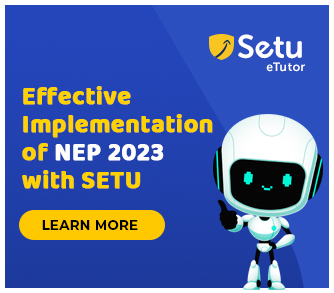
All Categories
- Assessment Reforms
Latest Blogs
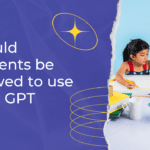
Should students be allowed to use Chat ...
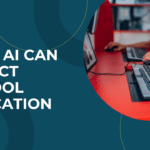
How AI can impact school education
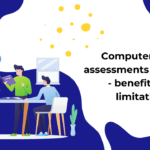
Computer-aided assessments in schools – benefits and ...
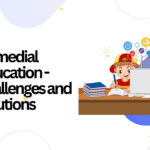
Remedial education – challenges and solutions
Copyright © 2023
- School Life
Latest Education News
Janmashtami Quotes, Wishes in Hindi 2024: इस श्री कृष्ण जन्माष्टमी अपनों को भेजें ये प्रेम और आस्था से भरे हार्दिक शुभकामनाएं संदेश
क्यों चर्चाओं में हैं BHISHM क्यूब्स, जानें
UPSC CDS 2024 Last Week Revision Tips: Check Subject-wise Strategy and Preparation
SSC Stenographer Previous Year Question Paper, Download PDF
Optical Illusion: Only 2% with high IQ can spot the number 79 in 5 seconds!
UPUMS Recruitment 2024 Notification for 82 Non Teaching Group C Vacancies
उत्तर प्रदेश के किस जिले में है रजा लाइब्रेरी, जानें
NABARD Grade A Admit Card 2024 Out at nabard.org: Download Assistant Manager Call Letter
ICC Women’s T20 World Cup 2024: किसका बदला कप्तान, कौन हुआ बाहर, सभी टीमों की फुल स्क्वॉड यहां देखें
Difference Between North Pole and South Pole
Maharashtra Becomes First State to Adopt Unified Pension Scheme: Who Will Benefit From This Decision?
Top 5 Govt Jobs of the Day-Aug 26, 2024: Apply Online for 1050+ Assistant Manager, Engineer, Faculty, Peon and other Jobs
MHT CET Counselling 2024 CAP Round 2 Provisional Allotment Out, Download at cetcell.mahacet.org
NBA Summer League 2024: Full Schedule, TV Broadcast Schedule, Live Streaming and More
Inland Waterways IWAI Recruitment 2024 Out, Apply Online for 37 Various Posts
JKSSB Patwari Admit Card 2024 OUT at jkssb.nic.in: Download SSBJK Call Letter
TNDALU Admission 2024: TNDALU LLM Seat Allotment Result Out at tndalu.ac.in; Check Fee Structure
NCERT Books for Class 10 Social Science PDF (2024-2025)
CBSE Class 10 Science Syllabus 2024-25 with Exam Pattern: Download PDF Here
CBSE Class 10 Maths Syllabus 2024-2025 with Weightage Distribution and Question Paper Design; Download PDF
26 Aug, 2024 | 9:09 PM IST
- Skip to main content
- Skip to navigation
- Screen Reader Access
Current Size: 100%

- Fundamental Rights
- Directive Principles of State Policy
- Fundamental Duties
- Rural & Urban Local Bodies
- Scheduled & Tribal Areas
- Centre-State Relations
- Organisation Chart
- School Education and Literacy
- Citizen's Charter
- Policy Initiatives
- Acts And Rules
- Telephone Directory
- Parking Label Application
- Who's Who
- School Education & Literacy
- Higher Education
- Documents & Reports
- School Education
- Expenditure on Education
- Miscellaneous
- School Education And Literacy
- National Boards
- Private National Boards
- International Boards
- YouTube Channel
- Photo Gallery
- School Education Dashboard
- Higher Education Dashboard
National Curriculum Framework for School Education 2023
- Constitutional Provision
- Allocation of Business Rules
- Advisory Bodies
- Government Services
Departments
Institutions.
- Covid-19 Campaign
- Archived Photo Gallery
- Terms & Conditions
- Privacy Policy
- Copyright Policy
- Hyperlink Policy
- Related Link
- Accessibility Statement
- Web Analytics
- Web Information Manager
- National Portal
- Public Grievances

Content of this website is owned and managed by D/o Higher Education, Ministry of Education. This site is designed, developed, hosted and maintained by National Informatics Centre (NIC), Ministry of Electronics & Information Technology, Government of India. Copyright 2021. All Rights Reserved.
Follow us on:
Supports: Firefox 2.0+ Google Chrome 6.0+ Internet Explorer 8.0+ Safari 4.0+
- Board of Regents
- Business Portal
- Contact NYSED

New York State Education Department

- Commissioner
- USNY Affiliates
- Organization Chart
- Building Tours
- Program Offices
- Rules & Regulations
- Office of Counsel
- Office of State Review
- Freedom of Information (FOIL)
- Governmental Relations
- Adult Education
- Bilingual Education & World Languages
- Career & Technical Education
- Cultural Education
- Diversity, Equity, and Inclusion
- Early Learning
- Educator Quality
- Every Student Succeeds Act (ESSA)
- Graduation Measures
- Higher Education
- High School Equivalency
- Indigenous Education
- My Brother's Keeper
Office of the Professions
- P-12 Education
- Special Education
- Vocational Rehabilitation
- Career and Technical Education
- Educational Design and Technology
- Standards and Instruction
- Office of State Assessment
- Computer-Based Testing
- Exam Schedules
- Grades 3-8 Tests
- Regents Exams
- New York State Alternate Assessment (NYSAA)
- English as a Second Language Tests
- Test Security
- Teaching Assistants
- Pupil Personnel Services Staff
- School Administrators
- Professionals
- Career Schools
- Fingerprinting
- Accountability
- Audit Services
- Budget Coordination
- Chief Financial Office
- Child Nutrition
- Facilities Planning
- Ed Management Services
- Pupil Transportation Services
- Religious and Independent School Support
- SEDREF Query
- Public Data
- Data Privacy and Security
- Information & Reporting
World Languages
- 2024-25 NYSSB Book Study - Promoting Multilingualism in Schools: A Framework for Implementing the Seal of Biliteracy
- NYSSB End of Year Data Challenge
- NYSSB Annual Reports
NYSSB Culminating Projects, Presentations, and Rubrics
- NYSSB One-Page Briefs for Students and Families in Multiple Languages
- NYSSB School Notification Form
- NYSSB Wakelet
- NYSSB for Colleges and Universities
- NYSSB in Languages with Multiple Varieties
- Criteria to Earn the NYSSB
- NYSSB Culminating Project Notification Form
- NYSSB End-of-Year Data Form
- NYSSB Guidance Toolkit
- Assessments
- Graduation Requirements
- Wakelet - Authentic Resource Collections
- 2024-25 Book Studies on The Keys to Strategies for Language Instruction: Engagement, Relevance, Critical Thinking, Collaboration
- 2024-25 Facilitator Book Study on Words and Actions: Teaching Languages Through the Lens of Social Justice
- Creating a Proficiency Mindset in your World Language Classroom
- Interpretive Communication for Classical Languages
- Enhancing Instructional Design: Aligning Your Daily Practice with the Revised Standards
- Checkpoint A Benchmark Proficiency Assessment Item Writing Workshop for Modern Languages
- Checkpoint A Benchmark Proficiency Assessment Item Writing Workshop for Classical Languages
- Using Authentic Resources for Proficiency Development from Checkpoint A to Checkpoint C
- Classical Language Lesson Planning
- Other Resources
- Languages Other Than English Publications
- World Language Associations
cul-project-presentation.jpg
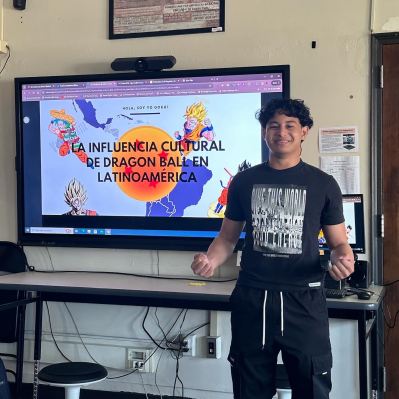
What is the Culminating Project?
Students may demonstrate the required level of proficiency for the New York State Seal of Biliteracy (NYSSB) in English and/or a world language by completing and presenting a Culminating Project, which can take the form of project, a scholarly essay, or a portfolio. The Culminating Project, when successfully completed and presented, may earn the student two (2) points for criterion 1E (English) and/or 2E (world languages) of the NYSSB.
What level of proficiency must a student demonstrate to satisfy the Culminating Project criteria?
Through the Culminating Project and Presentation, students must demonstrate the required level of proficiency based on the language of the project.
- For English and category 1-2 modern languages (those that use a Roman-based alphabet such as Spanish, French, Italian, German), the required proficiency level is Intermediate High.
- For category 3-4 modern languages (Indigenous languages such as Seneca and Tuscarora, those that use a non-Roman-based alphabet such as Arabic, Greek, Hebrew, and Russian, and those that are character-based such as Japanese, Korean, Mandarin, and Vietnamese), the required proficiency level is Intermediate Mid.
- For classical languages (those from an earlier time in human history that have no living native speakers such as Latin and ancient Greek), the required proficiency level is Intermediate High for Interpretive Reading.
How is the Culminating Project presented?
Culminating Projects are presented by the student in the language being assessed to a panel of at least two qualified adult speakers of the language. Panelists may include classroom teachers, other faculty and staff, and community members. Students present their projects and then the panel interviews the students in the language being assessed.
How is the Culminating Project and Presentation evaluated?
Projects are evaluated using a rubric that is aligned with ACTFL proficiency levels. NYSED has created sample rubrics in English for each of the language categories that schools may use to evaluate student work.
- Rubric for category 1-2 modern languages (those that use a Roman-based alphabet such as Spanish, French, Italian, German): Full-size rubric (multiple pages) , Condensed rubric (one page)
- Rubric for category 3-4 modern languages (indigenous languages such as Seneca and Tuscarora; those that use a non-Roman-based alphabet such as Arabic, Greek, Hebrew, and Russian; those that are character-based such as Japanese, Korean, Mandarin, and Vietnamese): Full-size rubric (multiple pages) , Condensed rubric (one page)
- Sample rubric for classical languages (those from an earlier time in human history that have no living native speakers such as Latin and ancient Greek): Full-size rubric (multiple pages) , Condensed rubric (one page)
The suggested NYSSB Culminating Project rubrics are also available in the following languages:
- Haitian Creole
- Mandarin Chinese
School-Developed Rubrics
Alternatively, schools may develop their own rubrics, which must be submitted to NYSED for approval with the NYSSB School Notification Form in December of each year. In order to be approved, school-based rubrics must meet the criteria established by NYSED based on the following essential questions:
- Is proficiency in the language being assessed the only aspect that is assessed on the school’s Culminating Project rubric?
- Are the column headings of the school’s Culminating Project rubric labeled with ACTFL proficiency levels?
- Are the performance descriptors in the school’s Culminating Project rubric aligned to ACTFL proficiency levels?
- Does the school’s Culminating Project rubric indicate the proficiency level required to earn the NYSSB?
- Does the school’s Culminating Project rubric separately address all three modes of communication (interpretive, interpersonal, presentational)?
Rubric used by NYSED to evaluate school-based rubrics
Get the Latest Updates!
Subscribe to receive news and updates from the New York State Education Department.
Popular Topics
- Charter Schools
- High School Equivalency Test
- Next Generation Learning Standards
- Professional Licenses & Certification
- Reports & Data
- School Climate
- School Report Cards
- Teacher Certification
- Vocational Services
- Find a school report card
- Find assessment results
- Find high school graduation rates
- Find information about grants
- Get information about learning standards
- Get information about my teacher certification
- Obtain vocational services
- Serve legal papers
- Verify a licensed professional
- File an appeal to the Commissioner
Quick Links
- About the New York State Education Department
- About the University of the State of New York (USNY)
- Business Portal for School Administrators
- Employment Opportunities
- FOIL (Freedom of Information Law)
- Incorporation for Education Corporations
- NYS Archives
- NYS Library
- NYSED Online Services
- Public Broadcasting
Media Center
- Newsletters
- Video Gallery
- X (Formerly Twitter)
New York State Education Building
89 Washington Avenue
Albany, NY 12234
NYSED General Information: (518) 474-3852
ACCES-VR: 1-800-222-JOBS (5627)
High School Equivalency: (518) 474-5906
New York State Archives: (518) 474-6926
New York State Library: (518) 474-5355
New York State Museum: (518) 474-5877
Office of Higher Education: (518) 486-3633
Office of the Professions: (518) 474-3817
P-12 Education: (518) 474-3862
EMAIL CONTACTS
Adult Education & Vocational Services
New York State Archives
New York State Library
New York State Museum
Office of Higher Education
Office of Education Policy (P-20)
© 2015 - 2024 New York State Education Department
Diversity & Access | Accessibility | Internet Privacy Policy | Disclaimer | Terms of Use
- Student Aid Policy
In Bid to Deter Misconduct, U.S. Releases New Data on Financial Aid Enforcement
The Education Department has issued $61.7 million in fines and cut off aid to 35 colleges for violations since 2021. Some critics say it hasn’t gone far enough in holding rule breakers accountable; others say the feds have a “vendetta” against career colleges.
By Katherine Knott
You have / 5 articles left. Sign up for a free account or log in.

A for-profit college based in Washington, D.C., that offered IT and health-care programs shut down in May 2023 after the Education Department cut it off from federal financial aid—one of 35 institutions in the last three years that have lost access to the funding source that’s a lifeline for most colleges.
But the department didn’t say anything publicly about its decision to take action against Prospect College after it found evidence of an "illegal scheme” to evade the so-called 90-10 rule. Under that rule, only 90 percent of a for-profit college’s revenue can come from federal financial aid. Prospect counted institutional payments to students as revenue to the college to keep its federal revenue under 90 percent, and when the department recalculated the college’s revenue for fiscal 2019, 2020 and 2021, the college failed the 90-10 standard all three years.
The department’s Jan. 31, 2023, finding against Prospect was disclosed along with dozens of others earlier this month, when the department released information about its enforcement efforts on a new webpage that will serve as the hub for future fines, settlements and termination actions. It is now public knowledge that the Office of Enforcement at Federal Student Aid, the agency within the Education Department that oversees the federal financial aid system, has taken 87 actions in all against 85 colleges and universities over the past three years.
Most Popular
- Report finds professors are burned out, thanks to technology
- Naropa sells main campus, betting on online future
- U of Alabama requires Black and LGBTQ+ groups to relocate
The disclosures are part of a new effort to increase transparency into the enforcement office’s work since it was revived by the Biden administration. Some of its more high-profile decisions have been released through press announcements, such as a $37 million fine against the online giant Grand Canyon University issued last October, but the majority have flown under the radar till now. (Most recently, the Education Department fined the Culinary Institute LeNotre $275,000 as part of a settlement agreement after finding that the Texas-based for-profit college misrepresented the employability of its graduates.)
This glimpse into the enforcement office’s work comes as the department is conducting an overhaul of Federal Student Aid—and with a presidential election on the horizon that could shake up the agency. The office, which was first created in the last year of the Obama administration, has been subject to political whims. Under the Trump administration, it was “deprioritized,” according to current Education Department officials who re-established it in October 2021.
Headed up by Kristen Donoghue, a former enforcement director of the Consumer Financial Protection Bureau, the office investigates potential misconduct, analyzes claims for debt relief from students who say they were defrauded and fines institutions, among other responsibilities.
“We investigate schools that are suspected of wrongdoing and take actions to hold schools accountable when we find evidence,” Donoghue said. “We want to ensure that schools do not put their interests ahead of students’ interests, and we are confident that the actions we take to hold schools accountable protect taxpayers who fund postsecondary education in addition to students.”
Over all, since October 2021, the office has issued 39 fines totaling $61.7 million and reached settlements with eight colleges, while yanking federal financial aid eligibility from nearly three dozen. It’s impossible to say how much of a stepped-up effort that represents, since the webpage doesn’t include enforcement actions under the Trump or Obama administrations. But department officials hope that the disclosures will be helpful for institutions who want to comply with federal rules and regulations—and will inform students and families as they think about which college to attend and which ones to steer clear of.
The latter category might include McDougle Technical Institute, which lost access to federal financial aid on Dec. 30, 2022.
The small Florida-based for-profit, which offers programs in cosmetology, barbering and massage therapy, showed a “callous disregard” for its students’ welfare, the department found. The college was accused of falsifying student attendance, disbursing federal financial aid to ineligible students, failing to give COVID relief funds to students and pressuring students to take out loans. In some cases, students were unaware that they had loans until department staff told them, according to a letter sent to the college. McDougle contested the decision and appears to continue to operate.
‘Need to Go Faster’
The data dump belatedly fulfills a March 2021 request from a coalition of consumer protection advocates and organizations focused on higher ed accountability. Some of those advocates said this month’s release of information was helpful—but that they’re generally disappointed in the office’s actions, now that there’s a fuller accounting of them.
The enforcement actions have been fairly standard; nearly half related to failures to comply with federal campus safety laws or federal reporting requirements. Of the colleges that lost aid eligibility, 13 lost it because they were no longer recognized by an accreditor—a baseline requirement for accessing federal financial aid.
Editors’ Picks
- Library Faculty Eliminated Amid ‘Fiscal Insanity’ at Western Illinois
- Re: Your Recent Email to Your Professor
- Wisconsin Regents Vote to Lay Off Dozens of Tenured Faculty
Advocates had hoped that the Biden administration’s Education Department would move more aggressively to go after universities that have misled or defrauded students, either with larger fines or revoked eligibility for federal financial aid.
“The enforcement effort is more serious, but has moved more slowly than the urgency of the problem requires,” said David Halperin, an attorney critical of for-profits. “I am impressed, but they do need to go faster.”
Halperin did appreciate this month’s disclosures. He said he raised concerns about Prospect College with the Education Department after Biden took office, but he didn’t receive any word about the institution losing access to the financial aid until the enforcement office posted its documents online this month.
Donoghue, chief enforcement officer at Federal Student Aid, said in an interview with Inside Higher Ed that her team will “always go where the facts take us and take action where we think it’s appropriate.”
“We have been very focused on building an investigation team that has skills in the background needed to do these investigations, and we have brought some actions that we think are very significant and warranted,” she said. “And we will continue to do that.”
Donoghue has worked to rebuild the office’s investigations team and put in place other tools that she relied on at the CFPB to “make sure oversight work is robust and complete.” That includes using undercover agents commonly known as secret shoppers to identify potentially deceptive practices and launching a tip line for “knowledgeable insiders” to share information about potential misconduct. So far, secret shopping has been used “at a number of schools,” Donoghue said, informing decisions about whether to proceed with an investigation.
“It’s a very valuable tool in our toolbox,” she said.
Will the office’s work over the last three years make it more resilient with a coming a change in administration, particularly if former president Trump returns to the White House? Donoghue said that while she didn’t have a crystal ball, “student and taxpayer protection is a nonpartisan issue.”
Halperin and other advocates who’ve followed the department’s enforcement work for years have noticed changes. He sees a new emphasis on enforcement “as opposed to a culture of labeling the school partners and bending over backwards to sweep violations under the rug.” That matters, he said, because “it tells schools that it’s time to behave and that having federal aid is a privilege.”
“At the very end of Obama, they started to wake up to all this stuff,” Halperin continued. “But there was still a lot of work to be done to overcome the history of institutional reluctance and avoidance of controversy or confrontation with institutions.”
But Thomas Jones, who leads the American Accountability Foundation, a conservative nonprofit, said that the Office of Enforcement “has been prosecuting a years-long vendetta against career colleges.” Others who represent for-profit colleges have also accused the Education Department of unfairly targeting career colleges via regulations and other actions.
“The office’s myopic focus on a sliver of the higher education landscape has come at the expense of ignoring abuses at traditional universities that often saddle students with over $100,000 in student loan debt with little prospect of gainful employment,” Jones said. “The only explanation for the Office of Enforcement ignoring traditional four-year universities is that liberals in the administration want to protect their traditional allies in academia."
Barmak Nassirian, vice president for higher education policy at Veterans Education Success, an advocacy group, said enforcement is one area where the Biden administration hasn’t “managed to soar as high.” He did give the Education Department “superlatively high grades” for their efforts to provide debt relief to students who need it, including those misled by their institutions about the value of their college educations.
“I wish they had more bandwidth to fix everything,” he said. “In some ways, I can’t blame them.” But “when abusive practices are normalized, it becomes a real challenge to change the culture of the regulated community. It’s not a couple of bad spots. This is a royal mess clear across the board.”
Nassirian noted that the department has limited tools to address noncompliance with federal rules—something he partly blames on congressional inaction. He acknowledged that the department has tried and put measures in place such as secret shopping to “improve the regulatory framework so that enforcement could be more meaningfully applied.”
“But have they cleaned it up?” he asked. “The answer is no.”

Suspended Protesters Fight Back With Lawsuits
Student protesters at three universities, suspended for violating campus codes of conduct, are suing their institutio
Share This Article
More from student aid policy.

Borrowers Reeling After Appeals Court Declines to Clarify Order
The order blocked the Biden administration’s SAVE plan and raised questions about the Education Department’s authorit

Increased Financial Aid Can Increase Demand for Basic Needs Services
A new survey from New Mexico shows that nearly 60 percent of students are food insecure.

Community Colleges ‘Back to Reality’ After Federal Relief
Community colleges spent much of their federal COVID-19 relief funds on student supports, technology and infrastructu
- Become a Member
- Sign up for Newsletters
- Learning & Assessment
- Diversity & Equity
- Career Development
- Labor & Unionization
- Shared Governance
- Academic Freedom
- Books & Publishing
- Financial Aid
- Residential Life
- Free Speech
- Physical & Mental Health
- Race & Ethnicity
- Sex & Gender
- Socioeconomics
- Traditional-Age
- Adult & Post-Traditional
- Teaching & Learning
- Artificial Intelligence
- Digital Publishing
- Data Analytics
- Administrative Tech
- Alternative Credentials
- Financial Health
- Cost-Cutting
- Revenue Strategies
- Academic Programs
- Physical Campuses
- Mergers & Collaboration
- Fundraising
- Research Universities
- Regional Public Universities
- Community Colleges
- Private Nonprofit Colleges
- Minority-Serving Institutions
- Religious Colleges
- Women's Colleges
- Specialized Colleges
- For-Profit Colleges
- Executive Leadership
- Trustees & Regents
- State Oversight
- Accreditation
- Politics & Elections
- Supreme Court
- Science & Research Policy
- State Policy
- Colleges & Localities
- Employee Satisfaction
- Remote & Flexible Work
- Staff Issues
- Study Abroad
- International Students in U.S.
- U.S. Colleges in the World
- Intellectual Affairs
- Seeking a Faculty Job
- Advancing in the Faculty
- Seeking an Administrative Job
- Advancing as an Administrator
- Beyond Transfer
- Call to Action
- Confessions of a Community College Dean
- Higher Ed Gamma
- Higher Ed Policy
- Just Explain It to Me!
- Just Visiting
- Law, Policy—and IT?
- Leadership & StratEDgy
- Leadership in Higher Education
- Learning Innovation
- Online: Trending Now
- Resident Scholar
- University of Venus
- Student Voice
- Academic Life
- Health & Wellness
- The College Experience
- Life After College
- Academic Minute
- Weekly Wisdom
- Reports & Data
- Quick Takes
- Advertising & Marketing
- Consulting Services
- Data & Insights
- Hiring & Jobs
- Event Partnerships
4 /5 Articles remaining this month.
Sign up for a free account or log in.
- Sign Up, It’s FREE
An official website of the United States government
Here's how you know
Official websites use .gov A .gov website belongs to an official government organization in the United States.
Secure .gov websites use HTTPS. A lock ( Lock Locked padlock ) or https:// means you've safely connected to the .gov website. Share sensitive information only on official, secure websites.
Dear Colleague Letter: Science Education Alliance-Phage Hunters Advancing Genomics and Evolutionary Science in Two-Year Colleges (SEA-PHAGES-TYCs)
August 13, 2024
Dear Colleagues:
The U.S. National Science Foundation's (NSF) Directorate for STEM Education (EDU), Division of Undergraduate Education (DUE) invites two-year colleges to submit a request for support to enable full participation in the Howard Hughes Medical Institute Science Education Alliance Phage Hunters Advancing Genomics and Evolutionary Science (HHMI SEA-PHAGES) program 1 . As part of this effort, this Dear Colleague Letter (DCL) announces a cooperative initiative between NSF EDU and the Center for the Advancement of Science Leadership and Culture (CASLC) at HHMI 2 . By joining forces, HHMI and NSF aim to leverage their respective expertise, resources, and networks to catalyze and expand support of the next generation of scientists. This initiative aligns with the National Science Foundation's 2022-2026 Strategic plan 3 by accelerating relevant STEM education enhancement efforts, cultivating a more inclusive and dynamic research ecosystem, and broadening participation in STEM.
The HHMI SEA-PHAGES initiative offers an authentic, yet accessible, course-based research experience (CRE) designed for students entering college-level science with limited or no prior research exposure. At the center of the SEA-PHAGES program is a community of STEM faculty who are supported to implement CREs collaboratively. Through this approach, the growing community of faculty members from over 150 institutions collectively engage over 6,000 undergraduate students in course-based research, support one another in the development of instructional practices to advance their pedagogy, and contribute to research projects aimed at enhancing undergraduate science education more broadly. The HHMI Science Education Alliance 4 , in partnership with NSF's IUSE: Innovation in Two-Year Colleges STEM Education (ITYC) program 5 , seeks to scale this transformative initiative to two-year colleges nationwide.
The ITYC program is a component of the NSF Improving Undergraduate STEM Education effort that is committed to supporting potentially transformative projects that seek to advance innovative evidence-based practices in undergraduate STEM education. Recognizing the importance of two-year colleges in the undergraduate education landscape 6 , the goals of the ITYC program are to: (1) center students in the effort to advance innovation, promote equitable outcomes and broaden participation for all students, and (2) enhance the capacity of two-year colleges to harness the talent and potential of their diverse student and faculty populations through innovative disciplinary, multi-department, and college-wide projects.
CALL FOR PROPOSALS
This Dear Colleague Letter encourages two-year colleges to submit planning proposals to the ITYC program , that focus on the activities associated with adapting and implementing the discovery-based HHMI SEA-PHAGES curriculum in laboratory courses within a two-year college biosciences program. Planning proposals responding to this DCL should align with ITYC goals and request resources required to participate in the SEA-PHAGES program and effectively adapt and optimize a CRE approach in a new environment. Proposals may include, but are not limited to, faculty and laboratory technician supports, equipment needs, and additional supplies necessary for implementation of the SEA-PHAGES curriculum. Resources can also be requested for efforts that aim to implement the SEA-PHAGES approach in unique contexts with diverse student populations, expand CREs across additional biosciences courses, and development of mentorship models that support student success in a CRE learning environment. Projects that connect SEA-PHAGES courses to the local community, embrace students' lived experiences, and/or generate knowledge about factors associated with the impact of this approach in the context of two-year colleges are particularly encouraged.
SUBMISSION AND REVIEW
Before submitting a planning proposal, a one-page concept outline and a consultation with an NSF ITYC Program Director is required. Guidance on Concept Outlines can be found in Chapter I.D.1 of the NSF Proposal & Award Policies & Procedures Guide ( PAPPG ). If approved, the NSF Program Director will invite submission of the planning proposal by email. The email confirming approval must be uploaded as a document in the Program Officer Concurrence Email(s) section of the planning proposal.
SEA-PHAGES-TYC proposals must be prepared in accordance with the instructions for the planning type of proposal contained in Chapter II.F of the PAPPG and must be submitted through Research.gov. Proposers should select the current PAPPG as the funding opportunity in Research.gov and direct the proposal to the ITYC program in the Division of Undergraduate Education (DUE) in the Directorate for STEM Education (EDU). The "Planning" type of proposal should be selected, and the proposal title should include "SEA-PHAGES-TYCs DCL:" after the prepended title "Planning:". Proposals should be submitted at the level of an ITYC planning proposal which has a funding limit of up to $100,000 per year for a maximum duration of two years. Proposals may be submitted by two-year colleges of higher education (either Associates College or Baccalaureate / Associates Colleges) that are accredited and offer undergraduate educational degree programs in science, technology, engineering, and mathematics (STEM).
Before submission, proposers must submit a separate application to the HHMI SEA-PHAGES program, available on the HHMI site . Proposals to this DCL are accepted at any time but must align with the HHMI application process. Proposals responding to this DCL should be submitted concurrently with an application to HHMI SEA-PHAGES or shortly thereafter. Two-year colleges that are currently members of the HHMI SEA-PHAGES community are encouraged to submit proposals to the regular ITYC program. Only institutions new to SEA-PHAGES are eligible for this funding opportunity.
NSF encourages proposals that include the participation of the full spectrum of diverse talent in Science, Technology, Engineering, and Mathematics (STEM) that attend two-year institutions.
Proposals submitted in response to this DCL will be shared with The HHMI SEA-PHAGES program team.
Principal investigators with questions pertaining to this DCL may contact:
- Kalyn Owens, Program Director, [email protected]
- Connie Della-Piana, Program Director, [email protected]
- Christine Delahanty, Program Director, [email protected]
- Michael Davis, Program Director, [email protected]
James L. Moore, III Assistant Director Directorate for STEM Education (EDU)
REFERENCES AND NOTES
1 Leading the World in Discovery and Innovation, STEM Talent Development and the Delivery of Benefits from Research: NSF Strategic Plan 2022-2026 .
2 Science Education Alliance-Phage Hunters Advancing Genomics and Evolutionary Science (SEA-PHAGES) Program: https://seaphages.org/ .
3 Center for the Advancement of Science Leadership and Culture (CASLC) at HHMI: https://www.hhmi.org/equitable-science .
4 HHMI Science Education Alliance: https://hhmi.org/programs/science-education-alliance .
5 Innovation in Two-Year College STEM Education Program site: https://new.nsf.gov/funding/opportunities/iuse-innovation-two-year-college-stem-education .
6 Foley D. Milan L., Hamrick, K: National Center for Science and Engineering Statistics 2020. The Increasing Role of Community Colleges among Bachelor's Degree Recipients: Findings from the 2019 National Survey of College Graduates.

IMAGES
COMMENTS
The New Education Policy 2023 thus aims to reduce the curriculum burden on students and will be more 'inter-disciplinary and multi-lingual'. The reforms begin with the model of examinations. Mother tongue promotion. The cornerstone of the New Education Policy 2023 is the importance accorded to education in one's mother tongue.
Innovative Shift in National Education Policy 2023 (NEP-2023) Under the Visionary Leadership of Prime Minister Shri Narendra Modi Ji and the Ministry of Human Resource Development, the New Education Policy of 2023 marks a pivotal milestone in the nation's educational journey. The policy was released on 29 July 2020 after approval by the Union ...
NEP-2020 approved by Indian Union Cabinet on July 29, 2020 which is set out the vision for new education system of each Indian. This policy is related to increasing access, improving quality and promoting the different area of research and innovation factor. The aim of policy is to function able or applicable by 2021.
RATIONALE FOR NEW EDUCATION POLICY 2023: The NEP 2023 aims to transform India's education system by addressing long-standing challenges of access, equity, and quality. It is driven by the desire to provide high-quality education to all, close gaps, and prepare students for a globalized economy.
Brown Center on Education Policy. From the continued response to pandemic disruptions to culture war issues that have surfaced in schools, 2022 was an eventful year for U.S. schools and education ...
The New Educational Policy (NEP) has directed states to implement FLN in primary school curriculums by 2025. The policy focuses on experiential learning, equipping students with 21st-century skills and reducing course content. Vocational education will be available in 6th-8th grade, along with internship opportunities.
Conclusion. In conclusion, the New Education Policy 2023-24 holds the promise of ushering in a new era of education in India. By addressing key areas such as holistic development, flexibility, skill development, and cultural inclusivity, the policy aims to create a robust educational ecosystem. Encouraging active participation and feedback from ...
Continuous Assessments: Include quizzes, projects, presentations, class participation, and other methods that gauge students' understanding rather than relying solely on high-stakes examinations. Competency-based Assessments: ... New education policy 2023 strongly emphasizes developing oral, written, and digital communication skills, ...
Urgent call for appropriate use of technology in learning and global guidance on generative AI in education. UNESCO's 2023 Global Education Monitoring Report on technology in education highlights the lack of appropriate governance and regulation. It urges countries to set their own terms for the way technology is designed and used in ...
The new education policy must provide to all students, irrespective of their place of residence, a quality education system, with particular focus on historically marginalized, disadvantaged, and underrepresented groups. Education is a great leveler and is the best tool for achieving economic and social mobility, inclusion, and equality. ...
In 2024, education and training systems have a 'unique potential' to build the foundations of equitable, sustainable societies. In the OECD National Survey for Comparative Policy Analysis 2023: Empowering Learners to go Green, 90% of participating systems identified environmental sustainability as a key priority for 2024.
The National Education Policy of India 2020 (NEP 2020), which was started by the Union Cabinet of India on 29 July 2020, outlines the vision of new education system of India. [1] The new policy replaces the previous National Policy on Education, 1986. [a] The policy is a comprehensive framework for elementary education to higher as well as vocational training in both rural and urban India.
Conclusion. Parliament panel's findings on the New Education Policy 2023 highlight both progress and challenges. While there's commendable progress in implementing the policy with initiatives like PM Schools and internationalization. However the issues such as limited accessibility, linguistic barriers, and funding gaps need urgent attention.
New Education Policy 2023-2024 India - Understand the key changes, reforms, and implications for the education system in this informative guide. ... One of the critical highlights of the new instruction strategy is the presentation of another 5+3+3+4 design for school training. This structure, which takes the place of the 10+2 structure that is ...
The annual comparative reports of the Education Policy Outlook monitor the evolution of policy landscapes mainly among the education systems of OECD Countries. The Education Policy Outlook follows the premise that knowledge of education policy is as valuable as the capacity to use it. Covering selected topics from early childhood education to adult education, the reports aim to provide a ...
The fundamental principles of the National Curriculum Framework are: Holistic Development: The NCF 2023 emphasizes the need for a holistic approach to education that promotes the overall development of students. It could include developing students' physical, emotional, social, and cognitive skills. Inclusivity: The NCF 2023 is likely to ...
NCF 2023: Get here Overview, Key Changes and Highlights of the National Curriculum Framework, in line with New Education Policy (NEP) 2020, for New Education System in the Schools.
In pursuance of this mission, the Ministry of Education (MoE) was created on September 26, 1985, through the 174th amendment to the Government of India (Allocation of Business) Rules, 1961. Currently, the MoE works through two departments: 1)Department of School Education & Literacy 2) Department of Higher Education.
Through the Culminating Project and Presentation, students must demonstrate the required level of proficiency based on the language of the project. For English and category 1-2 modern languages (those that use a Roman-based alphabet such as Spanish, French, Italian, German), the required proficiency level is Intermediate High.
The Education Department has issued $61.7 million in fines and cut off aid to 35 colleges for violations since 2021. Some critics say it hasn't gone far enough in holding rule breakers accountable; others say the feds have a "vendetta" against career colleges. A for-profit college based in Washington, D.C., that offered IT and health-care programs shut down in May 2023 after the ...
Rep. Carter Nordman, R-Panora (2023) Rep. Carter Nordman, R-Panora, chairman of the Iowa House education budget committee, through which Senate File 2435 advanced, said lawmakers wanted to help ...
August 13, 2024. Dear Colleagues: The U.S. National Science Foundation's (NSF) Directorate for STEM Education (EDU), Division of Undergraduate Education (DUE) invites two-year colleges to submit a request for support to enable full participation in the Howard Hughes Medical Institute Science Education Alliance Phage Hunters Advancing Genomics and Evolutionary Science (HHMI SEA-PHAGES) program 1.